

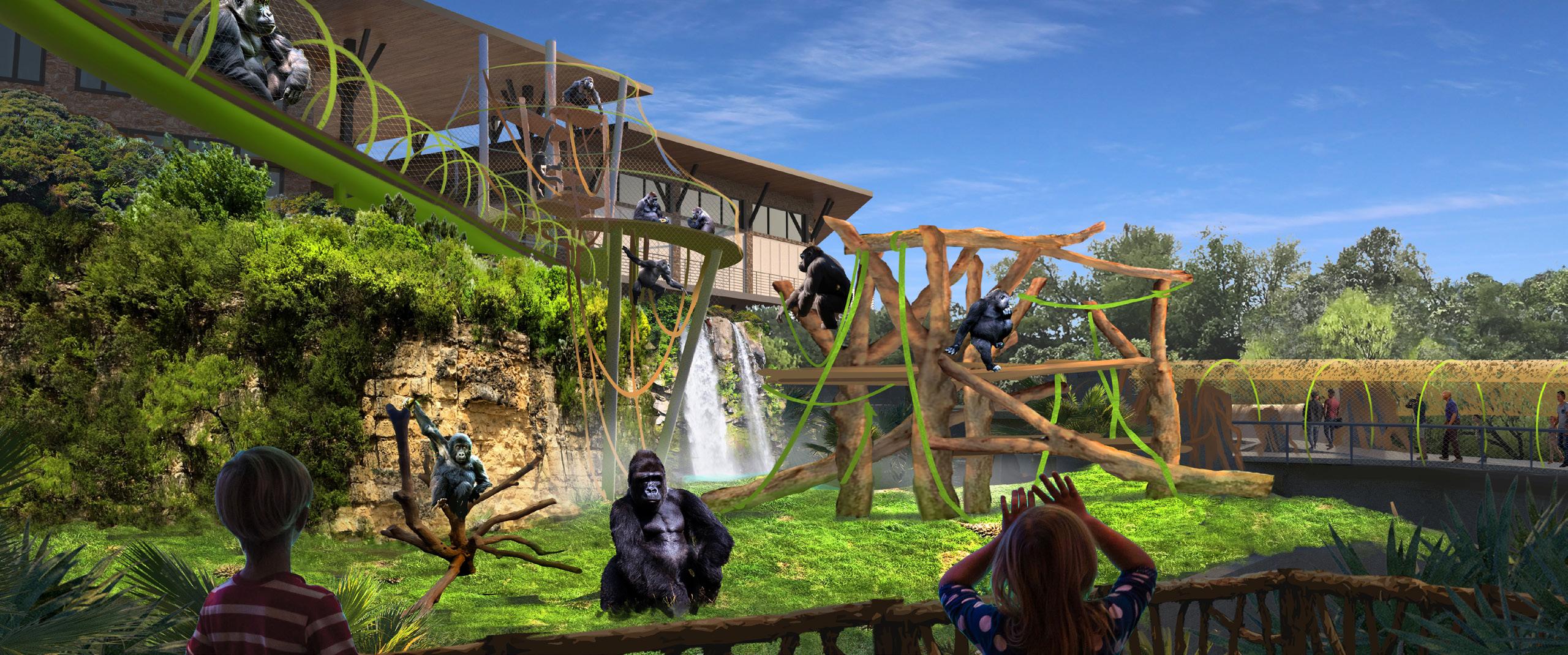


issue 98, July / Sept / Oct 2023 inparkmagazine.com Bringing gorillas into our midst Design habits and habitats on display at San Antonio Zoo

InPark Magazine (ISSN 15531767) is published by Martin Chronicles Publishing, LLC. 2349 E Ohio Ave. Milwaukee, WI 53207, USA. Shipping address: 2349 E Ohio Ave. Milwaukee, WI 53207, USA. Phone: +1-262-4127107. Printing by Johnson Press of America.
Contents © 2023 InPark Magazine. All rights reserved. Nothing in the magazine may be reproduced or used in any manner without the prior written permission of the magazine. InPark Magazine is not responsible for unsolicited manuscripts, photographs or illustrations. Such material must be accompanied by a self-adressed and stamped envelope to be returned.
Postmaster: Send address changes to InPark Magazine 2349 E Ohio Ave. Milwaukee, WI 53207, USA. Subscriptions are available annually for $45 per year ($70 international). Opinions expressed in editorial matter are not necessarily those of InPark Magazine or its publishers, Martin Chronicles Publishing, LLC.
ON THE COVER
The San Antonio Zoo turned to PGAV Destinations to design a new entrance and extensive gorilla habitats for both the animals and human guests to enjoy.
Page 30
7 Expo 2027 Belgrade
Exclusive interview with Dr. Dušan Borovcanin by James Ogul
11 Pathways to growth
Alcorn McBride’s innovative internship program for theme park engineers by Wendy M. Grant
16 Listening to operators
Q&A with Smart Monkeys CEO Stephan Villet by Judith Rubin
21 The era of spatial computing
Electrosonic connects themed entertainment and spatial computing by James Careless
24 TEA’s recipe for success
Events and networking fulfill an industry need by Martin Palicki
26 All about Brand Licensing Europe
Interview with Ella Haynes and Ben Roberts by Judith Rubin
30 Celebrating the community and the zoo
Three new projects by PGAV Destinations at the San Antonio Zoo by Joe Kleiman
36 Making the move to cashless
How Connect&GO can make operations easier with RFID by James Careless
40 Design & development
Five UCF grad students create concepts for Alterface’s The Wander by Judith Rubin
46 Helping yourself
Semnox streamlines the future of self-service in leisure venues by Tammie Richards
50 Taking a moment
Moment Factory: from music for the eyes to symphonies for the senses by Gene Jeffers
54 What’s in a MIRT (Mario in Real Time)?
SimGraphics ushers in well-behaved AI characters for LBE and themed attractions by Judith Rubin
team & contributors
PUBLISHER
Martin Palicki EDITOR
Judith Rubin
SENIOR CORRESPONDENT
Joe Kleiman
NEWS EDITOR
Joe Kleiman
Martin Palicki CONTRIBUTORS
James Careless
Wendy M. Grant
Gene Jeffers
James Ogul
Tammie Richards
DESIGN

3 inparkmagazine.com issue 98, Sept / Oct 2023
Just add technology
Martin PublisherPalicki,
Thissummer I was invited by Just Add Power to tour their new facility outside Tampa, Florida. The company’s founder, Ed Qualls, is a former IBM employee who developed the first HDMI over IP system back in 2008. Just Add Power has focused on AV over IP ever since, and prides itself on robust, easy-to-use components that the company pledges to support with live tech-help throughout the product’s lifespan.
During the tour, Qualls shared how his initial ideas were met with skepticism and even anger by the established AV community. But his instincts were right and the relative simplicity of the system has helped usher it into the marketplace in a big way. Among some of the early adopters? Theme parks and hospitality venues. Qualls himself is a big Disney fan – the company headquarters has nods to theme parks all over the place, including a Dole pineapple whip machine in the kitchen and a Disney magic band reader in Qualls’ cigar lounge, often used for company events.
Parks and attractions have long made good proving grounds for new tech. They are always building, expanding and rebuilding to keep guests coming back. Systems need to function for long hours every day and have minimal tolerance for failure. And if something can physically break, one of the tens of thousands of people coming into the park each day is going to figure out how to do it.
AV over IP has passed all these tests, so what new technologies are parks working with now? AI is certainly on top of mind. Designers and vendors are already incorporating some of AI’s more well-known features into their work. But there’s more; you can find some answers to that question within this issue. InPark has long been a pipeline between the technology community and themed entertainment. Our reporting in every issue helps shed light on upcoming and established tech that makes the guest experience better. Just like InPark, Qualls understands intuitively why good tech is so important to visitor attractions: “If we can provide technology that the operator doesn’t need to worry about, they are free to focus their time and attention on guests and the total guest experience.”
Martin founded InPark Magazine in 2004, combining years of experience working in themed entertainment with a passion for writing and design.


Joe Kleiman, Senior Correspondent
Raised in San Diego on theme parks, zoos, and IMAX films, Joe Kleiman would expand his childhood loves into two decades as a projectionist and theater director within the giant screen industry. In addition to his work in commercial and museum operations, Joe has volunteered his time to animal husbandry at leading facilities in California and Texas and has played a leading management role for a number of performing arts companies. Joe has been news editor at InPark Magazine since 2011, becoming the publication’s senior correspondent in 2021. His blog,ThemedReality.com takes an unconventional look at the attractions industry. Follow on twitter @themesrenewed
Erasing the line between theory and practice
Judith Rubin, Editor

Alterfacedesigned The Wander technology to give storytellers and operators extensive and profound options for the creation and implementation of interactive, non-linear guest experiences. We’re eagerly looking forward to seeing the first Wander-empowered experiences realized in the near future.
Meanwhile, a group of five graduate students from the UCF Themed Experience Program (in Orlando) set out to explore The Wander, with direct input and guidance from Alterface (in Belgium). The results of that exercise, published in this issue of InPark, show what great things can happen when industry and education join hands.
Collaborations such as this help students - tomorrow’s industry innovators and leaders - begin to grasp the real issues of attraction development. The Alterface exercise put cutting-edge tools into their hands and provided a platform for meaningful dialogue with the innovators.
The UCF graduate studies programs are headed by Professor Peter Weishar, a pioneer in themed experience education. They cultivate creative growth in partnership with industry, in exemplary fashion. These masters candidates are already working in the field, and the study program is tailored to accommodate that. Prof. Weishar brings experts and leaders into the classroom; he brings students into company settings; he forms ties to industry organizations and gets his students involved.
The students and the industry respond with enthusiasm. Alterface demonstrated the qualities that make them leaders in the field. Alterface principals were closely involved throughout this exercise and provided thoughtful feedback from a well of knowledge and experience, with keen awareness of the various practical and creative issues involved.
The industry’s growing academic arm reflects the characteristic bold creativity of the industry itself. These students don’t live in an academic bubble – they are learning in a transparent, collaborative setting. They will graduate already having connections and experience, a working knowledge of their chosen field and exposure to multiple disciplines – a strong basis from which to continue and contribute.
Judith helps drive content to serve the attractions industry, fostering professional connections, business development and the meaningful exchange of information. She has been contributing to InPark since 2005 and became editor in 2010.
4
inparkmagazine.com


5 inparkmagazine.com +1 407 839 1154 Creating next-generation themed attractions with experiential technology. Support Build Design



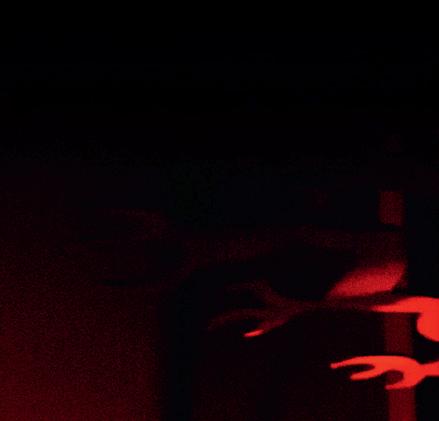
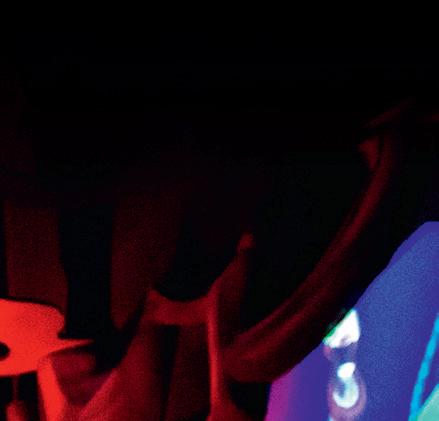

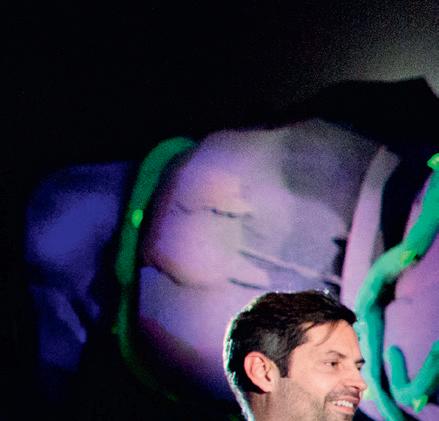



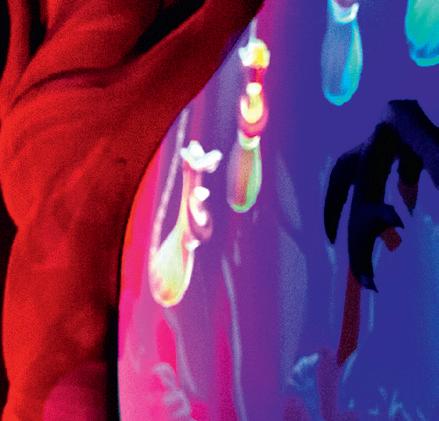










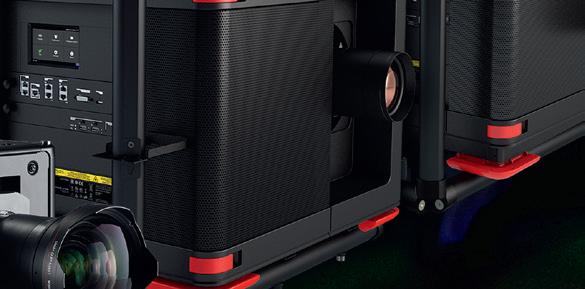






inparkmagazine.com Get thrilled with Barco projection Join the ride at www.barco.com/theme-park Treat your visitors with thrilling experiences all year long. Put a smile on your guests face from start to finish. Give tourists that memorable trip they won’t stop talking about. With Barco’s visualization and processing solutions you create the most magical experiences – ride after ride, day after day. Consistently delivered by our global team of experts Bringing peace of mind for any application Leading technology designed for immersive experiences
Expo 2027 Belgrade
Exclusive interview with Dr. Dušan Borovcanin
by James Ogul
OnJune 21, 2023, Member States of the Bureau International des Expositions (BIE) elected Serbia as host country of Specialized Expo 2027. Serbia prevailed in four rounds of voting over Spain, the United States, Thailand and Argentina. Expo 2027 will take place in Belgrade May 15-August 15, 2027 with the theme “Play for Humanity: Sport and Music for All.”
There are two categories of expos (aka world’s fairs or international expositions). Specialized Expos last up to three months and occupy not more than 62 acres; their scheduling windows are in between larger World Expos, which occur every five years. The most recent Specialized Expo was in 2017 in Astana, Kazakhstan under the theme “Future Energy,” and received almost 4 million visits.
For this exclusive interview, InPark’s expo specialist Jim Ogul spoke to Dr. Dušan Borovčanin, CEO of the Serbia Convention Bureau, and Project manager for the Bid Dossier of EXPO 2027 Belgrade.
Congratulations on Serbia’s winning bid to host Expo 2027 in Belgrade! Can you share some insights into the process that led to this success?
Thank you very much. This is indeed an historical success for Serbia.
Even though Serbia has a long history and tradition of participation at world’s fairs (The Kingdom of Serbia first participated in Antwerp in 1885) this was the first time we decided to bid for the role of host. Remarkably, we managed to win in a very competitive race between five countries.
I think the idea of bringing the expo to Serbia and the region inspired people to come onboard. We had a contagious energy all the way to the final vote.
Regarding the bid itself, I would say there were several unique features that helped us to convince delegates to vote in our favor. One aspect was certainly our unusual and engaging theme. Another was Serbia’s position in the international community. Finally, I think our professionalism through the entire process – from the very first meeting with the BIE secretariat, through numerous general assemblies, symposia,
receptions etc. – demonstrated our capability to do amazing work.

How will Serbia leverage this moment on the global stage?
The slogan of the Serbian Tourism Board is “Experience Serbia,” and I am sure every visitor of the EXPO in Belgrade will be privileged to experience the very best of Serbia.
This is a unique opportunity for Serbia and the entire Western Balkans region to showcase the best we have to the rest of the world, in every sense. Likewise, it is a wonderful opportunity for the rest of the world to get acquainted with the region’s amazing history, culture, science, and economic potential.

This region has an incredibly rich history and was often a place that trajected the course of history of Europe, and perhaps the entire world. I will just mention a few interesting insights that will most certainly find their way to the EXPO in 2027.
One of the earliest urban settlements in Europe, Lepenski vir, is located near Belgrade in Eastern Serbia. It is important because this is some of the earliest evidence of two cultures meeting and mixing. It speaks to the history of this region and the evolution of the human race.
Some of the world’s leading scientists such as Nikola Tesla, Mihajlo Pupin, Milutin Milankovic and Mileva Maric were Serbs. They transformed and influenced the course of our civilization. The Museum of Nikola Tesla in Belgrade, devoted to his legacy, will have a presence in the central pavilion.
Yet, although we are inspired with our past, when we were thinking about EXPO in 2027, we were thinking about the future. And the future seems uncertain today. Thus, our mission was to create an event where every individual and every community will learn how to become more resilient to the challenges we are all facing.
7 inparkmagazine.com
Dr. Dušan Borovčanin, CEO of the Serbia Convention Bureau, presents to the BIE. Photo courtesy BIE
We believe that using our power of imagination, creativity, and innovation inspired with play – characteristics we all share as humans since the moment we are born – can help us guide the human race forward. Since play is the essence of recreation, sport, and music we believe the EXPO 2027 could be the largest celebration of the global recovery in 2027.
Tell us more about the theme and how your group will express it.
We believe that there is no single person that can firmly tell you what our future holds. So, thinking of the theme for EXPO 2027 in Belgrade, we wanted to find one single element that can light the spark in every human being to make something good for humanity. This is what we identify as the power of play.
Play in its very essence connects us on the deepest and most basic level. It has lit the spark to some of the most advanced scientific discoveries, and finally, it simply brings joy and helps us better understand one another.
Inspired by play, curiosity, creativity and joy, we are certain that EXPO 2027 in Belgrade will showcase the most advanced discoveries, and that our visitors will enjoy coming back to EXPO several times throughout the three months of exhibition.
Hosting such a significant event requires extensive planning and infrastructure development. What are some key projects and initiatives?
This project will be alongside the development of Belgrade Metro lines, the largest urban development in Belgrade in the
last couple of decades. The EXPO site is part of the wider development project of our capital and it includes the construction of the National Stadium, the residential and hospitality area, a new university campus and sport facilities. It is ideally located between two main road routes in the country and well connected with Nikola Tesla Airport of Belgrade.
The concept project of our EXPO venue was made by the worldrenowned architectural studio Fenwick Iribarren Architects, which is known for the realization of mega facilities for mass events. For the 2022 World Cup in Doha, Qatar, this company designed three out of 10 stadiums, including the famous Stadium 974.
An enormous amount of work is ahead for us, but everything is much easier when you have an exciting and worthwhile goal.
Sustainability and environmental considerations are increasingly important for large-scale events such as world expos. What measures will Serbia implement?
Indeed. It is necessary to think sustainably when going into these projects. I would like to highlight that our focus is not only on environmental protection, but rather on sustainability in every sense – including economic and social sustainability.
As for environmental protection, one of the guiding ideas in developing the concept of the exhibition space was the use of renewable energy sources, the use and sustainable management of water resources (given the proximity of the Sava River site), a goal of zero emissions and integration of the site into the environment by implementing technologically advanced and long-term sustainable solutions.
The location itself and the immediate surroundings will be greened with landscaping solutions that support passive cooling, and appropriate water channels will be used for additional cooling. In addition, the master plan pays attention to surface materials under roofs and pergolas, and appropriate fans will be used with water spray to cool visitors, having in mind the time of year.

8
inparkmagazine.com
Conceptual view of Expo 2027 Belgrade grounds. Photo courtesy BIE
How does Serbia plan to engage and attract participation from around the world?
I am proud to say we have already received official invitations from several countries that expressed their interest to participate at the EXPO 2027 in Belgrade. Receiving these supporting messages makes us proud. You know, in the final voting round, we received the support of 81 countries. Having such strong support in the international arena, and with our engaging theme, I believe our team will not have a very demanding task negotiating the participation of international participants.
In terms of legacy, how does Serbia envision the impact of hosting the World’s Fair in 2027 on its economy, tourism industry, and overall international reputation?
The economic returns can be divided into three cycles. First, from now until opening day, the creation of new businesses and new jobs. Second, during EXPO 2027, the benefits of tourism.
Third, the legacy impact. The EXPO site was designed in order to continue its life as the biggest and most modern tradeshow complex in this part of Europe after closing day.
But also, to my mind there’s the intangible benefit: the immeasurable value beyond everything else is the international

reputation. This will be a unique opportunity to host the world in Serbia and, for younger generations in this region, instill a whole new mentality – a more positive sense of themselves and their value and purpose.
How can interested individuals and organizations stay updated and get involved in the preparations?
It is a well-structured process, led by the BIE. The new company EXPO 2027 Belgrade will be founded to manage the entire process. We expect this to be done not later than the end of September 2023. I’m sure EXPO 2027 in Belgrade will create enough room for every single individual and organization interested in contributing or participating. Currently, the official contact points are via web (expobelgrade2027.org) and email (info@expobelgrade2027.org). •
Since retiring from the US State Department in 2011 after a 30+ year career in world expos, James Ogul (jogul@comcast.net) has remained on the scene in an advisory and consulting role. He writes regularly for InPark Magazine about world’s fairs. See his free online book,Tales From the Expo


Pathways to growth
Alcorn McBride’s innovative internship program cultivates future theme park engineers
by Wendy M. Grant
In the rapidly evolving world of technology and engineering, companies are constantly seeking new talent and innovative minds. But what is the best way to attract and nurture such talent? We explored the immersive internship program of Alcorn McBride. This small-but-mighty company of 21 employees has evolved a successful model for welcoming and fostering the next generation of engineering professionals.
Since 1986, Orlando-based Alcorn McBride has been a leader in audio, video, and show control for the global themed entertainment industry. Its robust product lines - such as Binloop, RidePlayer, V16 and Winscript - help drive rides and attractions for pretty much every major theme park operator on the planet, as well as being installed in museums, cruise ships, casinos, and thousands of other venues.
“We look for smart, curious, talented people who want to learn about what we do,” says Loren Barrows, Chief Operating Officer at Alcorn McBride. And sometimes, those smart, curious, talented interns become employees. Today, the company counts two former interns as full-time staff: Justin Ruka and Bailey
Hamrick. They, along with current intern Allison Lloyd, talked with InPark about how they became Alcorn McBride interns, what an intern at the company does, and what their roles are today.

Connecting with the company
Alcorn McBride only brings on one intern at a time for the paid, part-time summer position, so opportunities are coveted and limited. Although applications are always welcome, key members of the Alcorn McBride team prefer to chat with students informally to assess the potential fit before inviting them to apply for an internship. Promising candidates next complete a series of interviews, which may be followed by an offer.
Justin Ruka grew up with a love for theme parks and technology. After graduating with a computer science degree from Lakeland University in Wisconsin, he looked for a way to break into the themed entertainment field. He relocated to Orlando in 2013 after being accepted to Disney’s internship program - the Disney College Program - at Walt Disney World.
11 inparkmagazine.com
Above, L to R: Alcorn McBride employees Justin Ruka and Bailey Hamrick, along with intern Allison Lloyd. All photos courtesy of Alcorn McBride
He also became an active member of the Themed Entertainment Association (TEA) Eastern North America Division. At a TEA monthly mixer, he met Barrows and Scott Harkless, Alcorn McBride’s Chief Innovation Officer. “Alcorn seemed like the perfect fit for my interests - blending my love of tech and theme parks,” says Ruka. So when they invited him to interview to become an intern, it was an easy “yes” from Ruka.
The newest full-time Alcorn McBride employee, Bailey Hamrick, took a different path. As a student, he set his sights on Alcorn McBride after reading Steve Alcorn’s book, Theme Park Design: Behind the Scenes With an Engineer. After his first semester at Baylor University, Hamrick built a 1/12 working model of Disney’s Enchanted Tiki Room and sent it to several companies, including Alcorn McBride. Barrows responded and encouraged him to get involved with TEA. Hamrick did so and then attended the annual TEA Summit conference (now TEA INSPIRE), and wound up sitting near Ruka. They struck up a conversation, then a friendship. They became coworkers when Hamrick was hired as an intern.

Allison Lloyd discovered Alcorn McBride at the 2022 International Association of Amusement Parks and Attractions (IAAPA) Expo in Orlando. The Georgia Institute of Technology electrical engineering student shares, “I knew they did electrical work, but I didn’t know the full scope. I wanted to know more. And it didn’t hurt that their booth was a tiki bar!” There, she met Alexander Wasson, the company’s CFO. They talked for quite a while, and he reached out to her later via LinkedIn about the internship program. Lloyd thought the opportunity sounded amazing and applied right away.
One thing that Ruka, Hamrick and Lloyd have in common is a proactive approach. They made a point of seeking out resources for professional development - joining associations, researching companies, shaking hands, attending conferences, and being open to learning what it takes to be part of their chosen industry.
An immersive internship experience

Alcorn McBride’s internship program is unique in that it offers the opportunity for interns to work closely with all members of the team and explore multiple areas within the organization. Barrows explains, “Just like our entire team, our interns do a little bit of everything. Depending on their interests, our interns will take on engineering projects or help with special events - or, oftentimes, both!” The experience gives interns vital real-world experience.
In Lloyd’s first week as an intern, she visited all of the departments, took part in 30-minute, informal meetings with everyone in the office, and then began learning how to assemble Alcorn McBride products. Now she spends about half of her day doing quality assurance (QA) testing and product assembly and packaging, and the other half doing engineering work such as testing and taking care of bug fixes. She notes, “I appreciate
12
inparkmagazine.com
Photos Above: Justin Ruka
Right: Bailey Hamrick
Opposite top: Allison Lloyd
Opposite right: Loren Barrows
the diversity of working on hardware and software, because it’s not common to do both. And it’s very fulfilling to work on products and program software for customers to use all over the world.”
Lloyd was also excited to work on the Attractions Technology Lab (ATL), a theme park attraction technology showcase that Alcorn McBride and various partners produce twice a year. ATL gives participants a chance to experience a complete installation, receive training, and ask technical questions. For interns, it’s an opportunity to learn about the versatile and collaborative nature of the industry. “Seeing our products in action in such a super-cool way was really fun,” says Lloyd.
Hamrick describes his internship as “playing in a great big sandbox of technology.” He was tasked with rewriting the software manual for WinScript, the show control interface that is at the heart and soul of many of the Alcorn McBride products found in the world’s most exciting theme park attractions. He says, “It was a good project because it forced me to understand how our software works at a very deep level, which helped me with other projects.”
Hamrick also got the chance to use the skills he’d displayed when he created that 1/12 model, by programming effects in the Alcorn McBride tiki room (known as The Tiki Teria), a unique space where the company demos products and entertains clients. Hamrick says, “Having all these toys at my disposal to learn about set a fire in me for this career.” Ultimately, he transferred to the University of Central Florida in Orlando to complete his computer engineering degree. Then he returned to Alcorn McBride for a second summer internship.
It’s no secret as to why Alcorn McBride interns bond with the company and want to keep coming back - and why employees remain with the company for decades. “The people and the company culture make this a great place to work,” Ruka says simply.


From intern to employee
Companies make an investment in their interns, and the goal of Alcorn McBride’s program is to find great candidates with
long-term employee potential. “Once they are on board we quickly learn if they’d be a great long-term fit here – as do they!” says Barrows. By giving their interns real challenges and opportunities, the company can better gauge their true aptitude.
Hamrick was confident it was a great fit from the start. “After my first two days of the internship, I realized all other jobs were doomed,” he says. When he returned to Alcorn McBride for his second summer internship, he got more hands-on experience with the company’s product range, learning how each one works, how it’s used in the field, and how to fix any issues. “It was a wealth of knowledge that allowed me to hit the ground running when I became an employee,” says Hamrick.
He was hired as a software engineer and began work as soon as his internship ended. Hamrick notes that the only difference between being an intern and being an employee is that he now works five days a week instead of two. “Every single day I’m blown away by my co-workers - by how passionate and brilliant they are,” he says. “It’s amazing to collaborate and see what we all can do together. We’re a small team, but we accomplish so much.”
Ruka echoes the sentiment and says, “There’s always opportunity for growth, which is why I’m still here.” Now Lead Sales Engineer, he has been with the company nine years and started out on the software team. He recalls that
13 inparkmagazine.com
as an intern, he developed Product Files, which are essentially device drivers that enable Alcorn McBride’s show controllers to communicate with other hardware in an attraction. At the end of his internship, he was offered a position. Like Hamrick, he found that transitioning from part-time to full-time was essentially seamless.
“Every moment I’ve spent here has been wonderful. I don’t want to leave!” says Lloyd, who is exploring what her next internship options might be before her expected spring 2025 graduation. One thing is certain: “I know I want to work in themed entertainment.”
Advice for future interns and employees
Alcorn McBride’s internship program is not only a worthy model for other companies to learn from, but something that enriches the entire industry, considering its success in turning interns into valuable, themed entertainment professionals able to adapt quickly to their new roles and build their dream careers.

“I think every student should do an internship,” says Barrows. It’s a great opportunity to learn firsthand what your chosen career path is like while you still have time to course correct - literally - if needed.” She encourages students to join TEA as student members and get involved with their school’s TEA

Barrows encourages anyone interested in an internship or position with Alcorn McBride to send in a resume and to chat with team members at the next industry gathering that presents an opportunity.
Ruka testifies, “It’s a great company that has helped me grow as an individual.”
Hamrick says, “If you want to learn about theme park engineering, work with your hands, and work on code, apply. You’ll do work that makes an actual difference.”

“We love what we do,” Barrows says, “and a lot of that is because we are always learning and trying new things. It’s fun to teach people new to the industry all the cool things we do here, and to learn from them, too!” •
Wendy M. Grant has worked in marketing for more than 25 years. She served as Director of Marketing and Communications for San Diego’s Fleet Science Center for 13 years. She served on the Marketing Committee for the Giant Screen Cinema Association and she was a board member for the Giant DomeTheater Consortium. Prior to working in the museum field, she was Director of Marketing at Marine Corps Air Station Miramar. Since 2019, Grant has worked as a communications consultant, writer and editor.
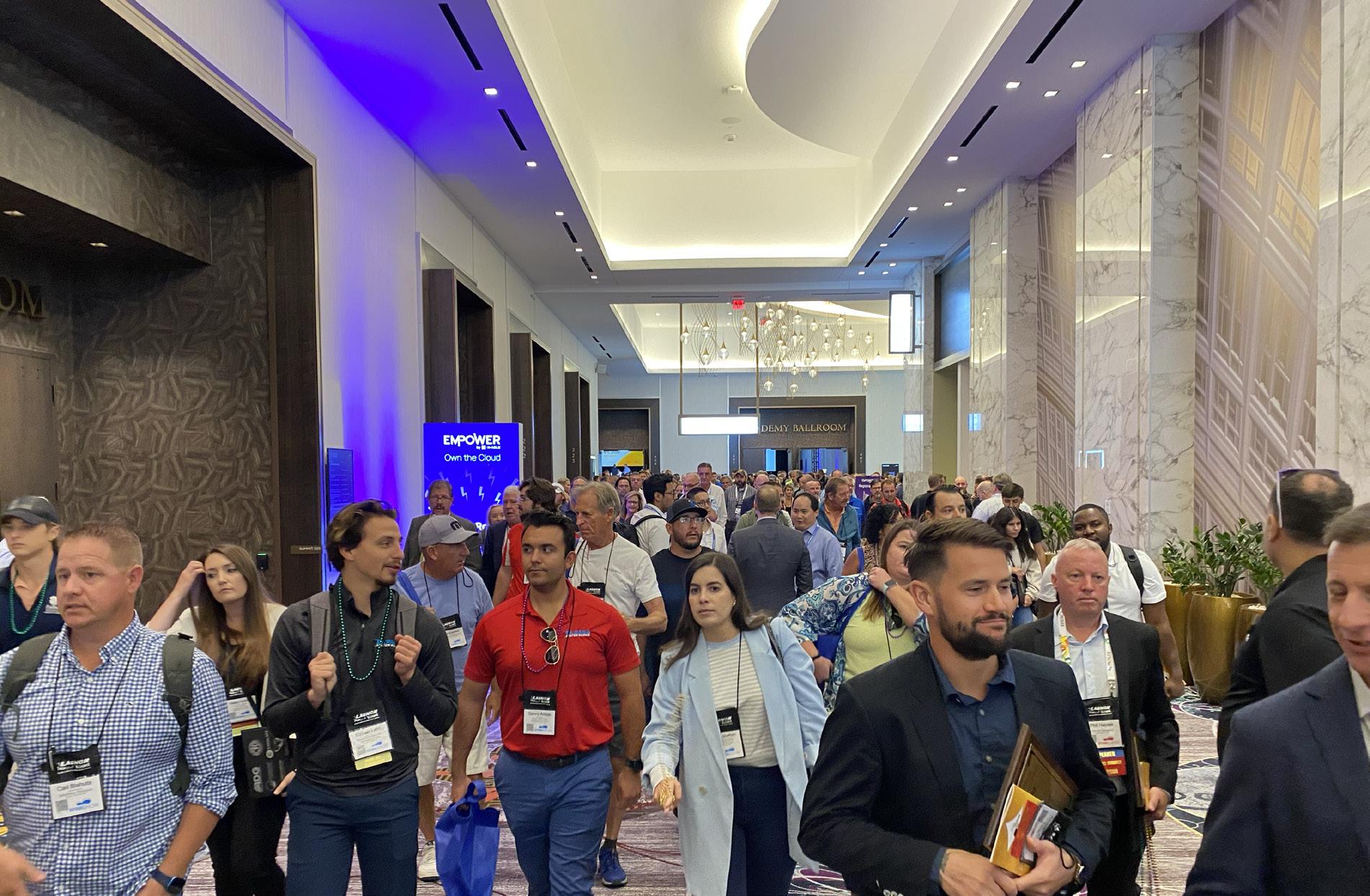





15 NEW ORLEANS, LA U.S.A. OCTOBER 24-27, 2023 TRADE SHOW OCT. 25 & 26 Visit wwashow.org to see the latest details in the “BigEasy!” The World Waterpark Association Show is the world’s largest gathering of water attraction professionals. Don’t miss the industry’s most complete education program and the biggest trade show dedicated to waterpark products and services. Questions? Call +1-913-599-0300 F
Listening to operators
Q&A with CEO Stephan Villet on the 15th anniversary of Smart Monkeys
 by Judith Rubin
by Judith Rubin
“It’sall about the workflow,” says Smart Monkeys CEO Stephan Villet, speaking to InPark editor Judith Rubin about how the company has grown and evolved in unexpected ways. Smart Monkeys is the creator of ISAAC, a revolutionary workflow and multimedia management platform that had its first big exposure to the industry in 2013 with its first airport installation - the Tom Bradley Terminal at LAX, which was honored with a Thea Award. Today, the company is well positioned to move forward with a multifaceted staff, and many prestigious manufacturers have aligned their products with ISAAC.
Congratulations on 15 years! What’s the single biggest milestone for the company?
We began as a service company and evolved to being a product and service company. This was not part of the original plan, but ISAAC - the product - had other ideas. The ISAAC platform is now a big part of what we’re known for.
Is themed entertainment still your primary market?
Yes and no. Again, it’s ISAAC’s fault - for being so versatile. Themed entertainment is still our first love, but ISAAC has been embraced by many different kinds of clients around the world, and this has grown the company and broadened our reach. We’ve opened distributorships in several countries, including China, Australia, Italy, France and the Benelux region. We are now working on our biggest projects ever, with our biggest clients ever, but unfortunately can’t share the details.
We’re still very much part of the attractions industry, and look forward to networking at IAAPA Expo in Orlando this year. We’re also active in the Themed Entertainment Association (TEA) – we are a headline sponsor for several TEA mixers in Orlando, and will host an open house in October. Our presence in Orlando has grown substantially.
How has the company itself adapted to address the changes?
For one thing, we have grown to have 26 team members (we started 15 years ago with two). More dramatically, we re-organized the company this year. We’re separating the service, which is niche-oriented, from the product, which is broader. This establishes a more standardized way to get the product to customers, through a resale network and distributors.
Smart Monkeys now has three departments, (design, operations, and product) each with its own leader and team, and its own roadmap and goals, although some projects encompass all departments. As CEO I concentrate on strategy and growth, while the team is more focused on project execution and product development.
Pre-Covid, almost all of us were based in Miami. We’ve since expanded the Orlando presence, plus we have staff working remotely in eight US states and Canada. Despite logistical challenges, this arrangement allows us to build stronger teams, hire the very best talent and better support our clients.
We are mainly working B2B, so in a sense, the evolution of how we work in response to today’s conditions reflects how our clients also now work. As a result, we are well aligned with client needs on both the product and service side, and able to take a more proactive, collaborative role.
A very big part of what we do today is designing: the ITcentric part of a design. We also do a lot on the side of remote support: 24/7 support for the biggest clients. We stay involved throughout the project process, and often for years after, providing support.
The experience we gained by developing a product has trickled down to our project service offering. For instance, we’ve extended our service offering to include custom application
16
Brightsign Crestron ETC Medialon NanoLumens Node-RED OMNIS by MegapixelVR PIXERA PIXILAB Q-SYS Realmotion ZeeVee ISAAC partners, a partial list
inparkmagazine.com
Smart Monkeys’ Stephan Villet shows off the new ISAAC Foundation 100 Series during InfoComm 2023.
development, which has proved quite successful. We can’t wait to share more info on some of the major projects we are working on!
Please give us a refresher on ISAAC.
Attraction operators have very specific needs that have generally called for bespoke solutions and programming to facilitate interacting with systems. (Yes, there are interactive smart devices people use every day, but these were developed by companies with huge workforces. In a niche industry, the resources are lacking to achieve that type of mass solution.)
ISAAC makes it possible to skip having to create yet another new custom environment, by providing a platform and portal – an ecosystem – that can be customized for any and all occasions, and that can expand and evolve its functionality while maintaining a consistent user interface. What the system enables the operator to do in terms of running an attraction will depend on their needs - but interactions within the system (user access, creating profiles, making decisions, scheduling, etc.) are the same for everything. It’s all about the workflow.
It’s sort of like your favorite organizing software, on steroids! ISAAC is really a user interface framework with some features ready to be used, that allows users to concentrate on the custom part they need embedded in order to control their equipment. The fact that it already exists and runs in a basic form makes it simpler to present to an end user – a reseller or integrator can demonstrate it to their client without having to create sketches. And because it provides this framework, ISAAC
helps programmers concentrate on the creative part of what their client needs. It’s also modular, and substantially reduces hardware requirements while providing redundancy by using virtual equipment.
Who needs ISAAC today?
I am absolutely certain that almost every project could benefit –not for any specific out-of-the box feature, but because it gives a foundation, a place to begin when assembling a custom system. Right now, the drive to the market is largely because of thirdparty entities, such as integrators, who realize ISAAC will help them sell their services and do a better job overall.
Also feeding demand is the ability to support today’s extremely diverse range of projects: media-centric experiences, rides and attractions, cruise ships, sophisticated audio, theater, multimedia systems that run through an entire venue (such as a theme park or airport), both guest-facing and user-facing, etc.
Some of the biggest venues in the world today rely on ISAAC to operate their systems. The idea is to have a stable base, a single portal from which to operate the system. With ISAAC in place, we know we are going to have the resources and the basis for building the custom system. You have what you need without having more than you need.
Tell us more about ISAAC and airports.
LAX was a decade ago, but in the last 12 months alone we delivered systems and services for airports in Doha, Nashville,

17 inparkmagazine.com
The new termial at Orlando International Airport features art+media installations that run on ISAAC. Photo courtecy of Float4
Newark, and Orlando, and there are more to come. Airports have big media - getting bigger all the time - and they need a way to operate that media without having to get hands-on with the media servers.
How do ISAAC partnerships work?
Every new partnership adds value by making new features and potentialities available within the ISAAC ecosystem. New partners come in every day, and this keeps the platform evolving and growing. Users can tap the new features to expand the capabilities of their systems without new programming.
[See sidebar]
Any system that can be programmed can be tied back to ISAAC. Any manufacturer that wants to support ISAAC can do so by implementing the available API, which is fully documented and supported. There is no approval process per se, and no fee - they do the work and follow the protocol; we test it and create a branded module. The API is limited to a very specific feature set, which protects the integrity of the ISAAC foundation.
You’ve achieved considerable success and acceptance for ISAAC. But that hasn’t been simple, has it?
Initially – for the first few years – there was pushback, but then an incredible shift and it’s a very big part of our industry today. For our industry’s younger generation, the question is not whether to use the technology, it’s how to use it in the right way, the best way.
The product is much easier to show and explain today than it was in its first years. And there’s deeper understanding of the benefits of an IT-style approach within our three primary markets – entertainment, museums and architectural media. Within those markets, one-off projects and the need to refresh and innovate year after year are the rule. They continue to need – increasingly so – non-standardized technologies for the sake of creating experiences that are unique and compelling. Clients and designers are assembling tech in a specific way, always pushing the boundaries. At the same time, it is rarely feasible or sustainable for operators to maintain a fully staffed department to monitor that type of install.
Operators need systems that are smart but that can be operated with a low-tech entry level; systems that are smart enough to internally recognize and resolve issues as they arise. They need a tech partner who will listen to them and support them and their team, and do it reliably, over the long term. We don’t deliver the “wow” factor – we deliver the system that enables you to deliver the “wow” factor, 24/7/365.
Listening to what operators need is really our forte, what we do. Again, it’s all about the workflow. •
Smart Monkeys: Some of the many projects over the years
Expo 2010 Shanghai - Electrosonic selected Smart Monkeys to provide Medialon show control programming for China Mobile and China Telecoms Information & Communications Pavilion, and for the USA Pavilion.
Universal’s Cinematic Spectacular (2012) - Smart Monkeys designed a system to run two sophisticated attractions off one show control system, operable from a single control booth.
Big “O” show for Expo 2012 Yeosu, (2013 Thea Award recipient) - Smart Monkeys programmed a show control system to synchronize hundreds of devices and special effects.
2013 – Honored with more than a dozen awards, the Tom Bradley Terminal multimedia presentation system at LAX uses ISAAC to allow the operator to schedule all media in the terminal from a single interface.
2018 – MGM Cotai spectacle, Macau - Smart Monkeys collaborated on designing the video and control center, and partnered with Electrosonic to design and program a fully IT-integrated system featuring ISAAC

2018 – Warner Bros. World Abu Dhabi – Nearly all the AV, projection, media, lighting and special effects throughout the park are supported by ISAAC.


2019 – RealMotion used ISAAC to develop a system to ingest content into the server to manage and synchronize millions of content elements for multimedia shows on the façade of the guitar-shaped Seminole Hard Rock Hotel & Casino (Hollywood FL)
2019 – ISAAC is adopted into Pursuit’s FlyOver attractions, starting with FlyOver Iceland in Reykjavik.
2022 – Smart Monkeys is an Illuminarium technology partner, with ISAAC in the multimedia control backbone of these innovative experience venues.
18
inparkmagazine.com
Courtesy MGM Resorts International

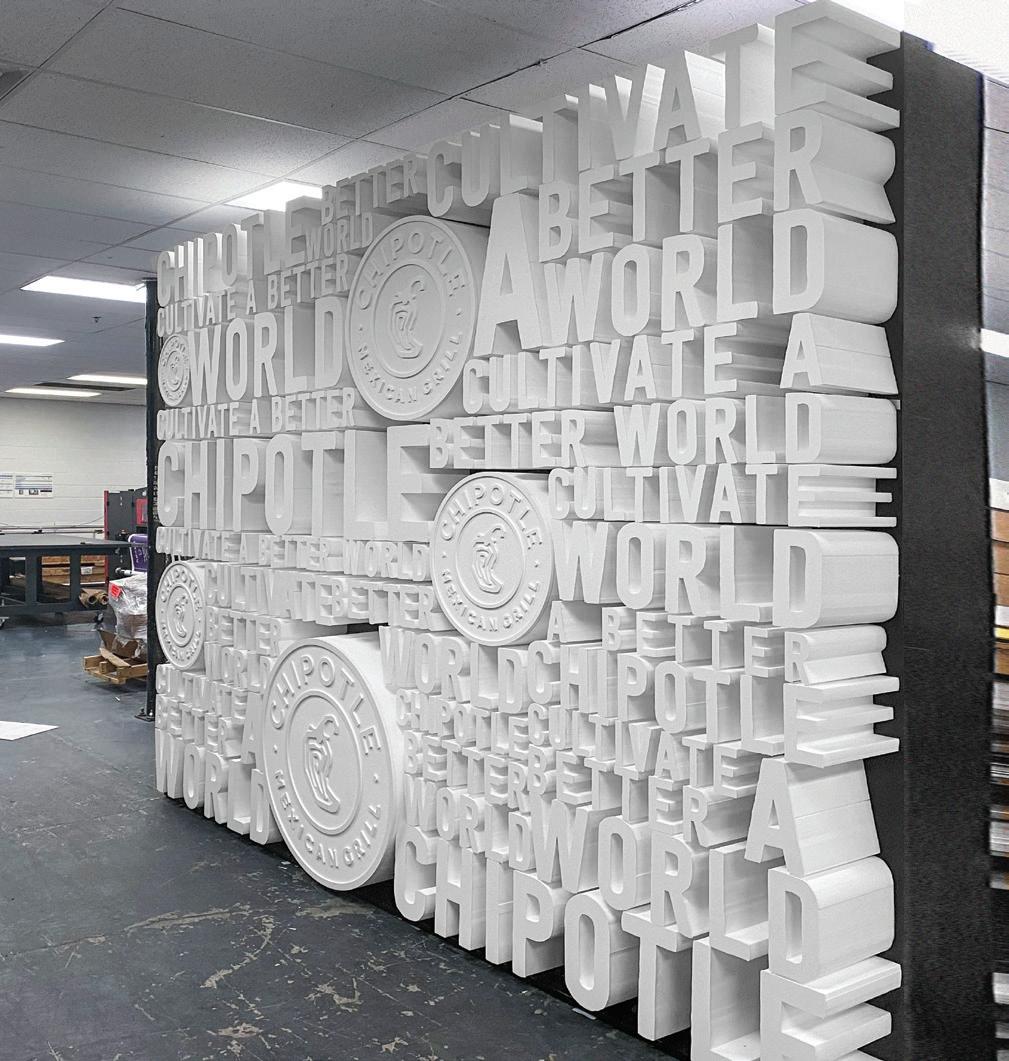


www.IMAGEENGINEERING.com 4 1 0 . 3 5 5 . 2 0 5 5
The era of spatial computing
Electrosonic makes the connection between themed entertainment and spatial computing
by James Careless
What, exactly, is spatial computing - and what does it signify
in the attractions industry?
“Welcome to the era of spatial computing” is one of the first things you see on the website for Apple Inc.’s new Vision Pro augmented reality headset. At Electrosonic - an international audiovisual and technology services company with nearly 60 years of designing, building and supporting experiential technology - “spatial computing” is seen as a term that is still evolving.
Yiannis Cabolis, Director of Technology Innovation, Electrosonic, describes spatial computing as “the utilization of digital technology to facilitate computer interaction within a three-dimensional realm” – essentially, providing interface between humans and digital volumetric applications.
Spatial computing is an umbrella term that includes many technologies such as virtual, augmented, mixed, and extended realities. It enables a variety of capabilities such as mapping applications that help you navigate an unfamiliar area, openworld video games where you are free to roam the digital landscape and discover areas at your own pace, and messaging avatars that allow you to assume a digital persona through recorded or real-time conversations.
For amusement park and attractions owners, spatial computing opens up a whole new virtual world of possibilities. Guests could visit three-dimensional models of the venue prior to their visit to plan out their experience and get a sense of what’s to come.
Video kiosks in a park could allow people to become their favorite character through a digital overlay on the screen.

21 inparkmagazine.com
The Snorri Touren dark ride at Europa-Park in Germany is a Thea-recognized project that Electrosonic worked on. Photo courtesy Europa-Park
Rides could incorporate personalized gamification through augmented reality – allowing riders to interact with virtual elements as they move through the physical space.

“By employing spatial computing, actions and interactions between machines, individuals, objects, and their surroundings can be enhanced and optimized,” said Yiannis Cabolis.


To make these new experiences feasible, an array of technologies need to be deployed. For certain scenarios, “Spatial computing heavily relies on sensors and input devices to gather real-time data about the physical environment,” said Cabolis. “These devices can range from cameras and depth sensors to motion trackers and haptic devices. By capturing depth, motion, and gestures, they provide vital inputs for spatial computing systems.” Bolstered by these powerful elements, “spatial computing enhances storytelling by providing immersive environments, enabling interactivity and user participation, offering multidimensional narratives, augmenting the context, facilitating collaborative storytelling, and intensifying emotional engagement,” he noted. “These capabilities open up new possibilities for storytellers to create compelling and memorable narrative experiences.”
An era of new possibilities
While spatial computing can be a driver of new experiences, it can also be leveraged to plan and design those experiences. Technology previsualization – another application of spatial computing – allows theme park and attraction owners to see their space before it is built. “Architects are great at creating really nice conceptual images,” said Ryan Poe, Director of Technology Solutions. “But if our clients at the parks are going to invest significantly in these projects, they need to have confidence that the end results are going to match their expectations. This is why we’re focused on creating high fidelity depictions of what the spaces and the technology within them will actually look like. Of course, you can do that by physically building mockups ahead of time. But again, there’s a lot of expense and effort that goes into that. If we can do that
digitally, it’s a lower initial cost and then we can make changes on the fly.”
Designing LED video walls is just one example where previsualization can be effective. “One pixel pitch, in theory, might be much cheaper and more affordable than another for either a screen or an LED wall,” said Lydia McDaniels, Building Information Modelling Designer and previsualization expert at Electrosonic. “But it may not perform as other pixel pitch options in practice. Technology previsualization can help you visualize the actual differences between those pixel pitches, and how this will affect how the display is going to look in real life. This knowledge helps our clients make the best decisions when it comes to what they’re putting their money into before they actually commit to building it.”
McDaniels uses powerful 3D modeling tools and game engines to create pixel-accurate representations of spaces and experiences before a hammer ever hits a nail. But the benefits extend beyond just planning and preparation. If these detailed models are connected to real-world feedback, then a “digital twin” can be created. This virtual version of an actual space can be manipulated without affecting the real environment. The benefit of having a digital twin is that “a park could test alternative content in the digital twin without having to actually shut the physical attraction down to test it out there,” said Poe. In fact, all proposed changes to the attraction could be made to a copy of the digital twin to see what works and what doesn’t — all without the cost and disruption of shutting down the real attraction.
These are some of the powerful possibilities of spatial computing for the amusement parks and attractions industry. Collectively, they have the ability to allow owners to deliver new experiences and make better decisions in creating new attractions and updating existing ones, while controlling costs, avoiding project delays, and minimizing disruptions on their properties.
22
Lydia McDaniels
Ryan Poe
inparkmagazine.com
Yannis Cabolis
Electrosonic and themed entertainment
Since its founding in 1964, Electrosonic has been at the forefront of sophisticated attraction design and implementation. The company has helped design innovative AV and media systems for many attractions that have received Thea Awards, including Snorri Touren at Europa-Park, honored in 2021 with a Thea Award for Outstanding Achievement. Electrosonic also led key audio, video and automation roles in attractions such as Masha and the Bear Land of Laughter at Land of Legends in Antalya, Turkey; and The Globe 30-foot interactive LED illuminated sculpture at AT&T Discovery District, an award-winning city district in the heart of Dallas, open since June 2021.
“We have a collective know-how that, in my opinion, is second to none because we have been around for quite some time,” said Cabolis. “We are also unique due to our Technology Partner program at Electrosonic, which brings together cutting-edge technology innovators in both hardware and software to create synergies among like-minded companies, enabling the creation of world-class experiential technology.”
Added Poe, “Along with a focus on shared innovation, this program aims to establish collaboration among members, embedding shared values while supporting customers globally in designing, building and supporting world-class experiential technology spaces.”
Welcome to the era of spatial computing in themed entertainment! •

Electrosonic’s Design Consulting practice leverages nearly 60 years of global experience combining creativity, innovation and AV system design to support the creation of great guest experiences. Through emerging technologies such as spatial computing, they collaborate with theme park operators, designers and creatives throughout the entire project life cycle. Visit www.electrosonic.com.
James Careless is an award-winning freelance writer who has covered the amusement parks and attractions industry for many years.

23 inparkmagazine.com
Electrosonic played a key A/V role in Masha and the Bear Land of Laughter at Land of Legends in Turkey. Photo courtesy Land of Legends
TEA’s recipe for success
Events and networking fulfill an industry need by
Martin Palicki
TheThemed Entertainment Association (TEA) has a winning formula when it comes to crafting industry events. With a headquarters in the US and a network of member volunteers around the globe, one of TEA’s specialties is in connecting themed entertainment professionals. Through their core tentpole events along with a steady stream of networking mixers and behind-the-scenes tours, the organization has over 1,600 members around the world.
One of their biggest events, TEA INSPIRE week and the Thea Awards Gala, took place at The Disneyland Resort April 13-15. The two-day INSPIRE conference was an updated version of the TEA Summit. Historically, the second day of Summit featured case studies of the year’s Thea Award recipients, and for INSPIRE that concept was expanded to include half of the first day as well. The INSPIRE Leadership Forum took place on the morning of the first day, allowing high-level executives and business owners an opportunity for round-table discussion on important issues facing the industry.
The week culminated in the annual Thea Awards Gala, a black-tie event where project owners receive Thea Awards and share stories alongside the vendors that brought the recognized projects to life.
TEA is smart to recognize that key to any successful event is to build in a multitude of networking opportunities. In addition to
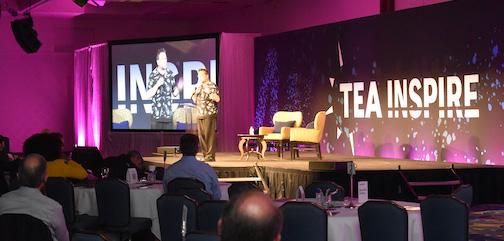
group luncheons, happy hour mixers and plenty of breaks, the entire Disneyland Resort property functions as a meeting space. Inspired by the stories of success presented in the Thea case studies, people gather outside the Trader Sam’s bar, on couches by the hotel entrance and at coffee tables in the conference center lobby to share ideas and forge connections. Perhaps most importantly, the event succeeds at bringing operators and vendors together in the same space.
New this year were Thea project breakout sections. After a general presentation from several projects, attendees could sit in on a small group session with one of the project presenters, allowing for more personal connections and extended Q&A time.
The Thea Awards Gala also afforded ample opportunity to mix and mingle. An extended happy hour preceded the show, produced this year by RWS Entertainment. After the event, the party continued in the ballroom lobby as well as at two of the resort’s hotel bars.

SATE Europe
Taking place at the Europa-Park resort in Rust, Germany May 3-5, SATE Europe is another of TEA’s flagship events. Crafted with a European flair and attended by TEA members and supporters from around the world, SATE Europe has a reputation for being an outstanding networking event, and this year’s edition did not disappoint.
The week started with an exclusive visit to Eatrenalin, Europa-Park’s new dining concept. After a glass
24
Attendees gather at TEA’s networking lunch at the Saudi Entertainment and Attractions Expo.
inparkmagazine.com
The TEA INSPIRE event reimagined the Summit two-day conference.
of bubbly, guests were taken 16 at a time to individual seats that were actually ride vehicles, moving through different themed rooms. Each room had a different course and wine pairing (non-alcoholic versions available too). The experience was unlike anything else I’ve seen, and SATE attendees wanted to know more. I think a few even wanted to open up an Eatrenalin franchise!
Thursday and Friday were the main conference days, with sessions on a wide variety of topics, from designing parks with AI to real-world accessibility issues and more. In-between were leisurely lunch hours, with plenty of time for meeting new people, and nightly dinners. Thursday’s Viking-themed night began with a parade of faux-fur-adorned attendees marching through Europa-Park to the Pirates of Batavia boat ride, followed by an address from TEA’s newest Thea Lifetime Achievement recipient, and co-founder of Europa-Park, Roland Mack.

After Friday’s sessions, attendees headed to the resort’s Krönasar hotel for a buffet dinner and evening access to the attached indoor/outdoor waterpark, Rulantica. After a facility tour, guests changed into swimsuits to try the park’s collection of slides and attractions. Attendees also had special access to the park’s clothing-optional saunas. Perhaps the event’s success can partially be judged by the attendee What’s App chat after the event ended. It seemed almost like the end of summer camp, with everyone extremely thankful for the organizers and new friends they made during the week.
Saudi socializing

The final ingredient to TEA’s secret sauce can be found in its smaller events. An association has to follow where the business is, and right now that means the Kingdom of Saudi Arabia. The association recently held a lunch mixer at the Saudi Entertainment & Attractions Expo in Riyadh. Simple and straightforward, the event consisted of plenty of networking time, followed by a very brief round of speeches and an ample lunch buffet. Sponsored by Top Notch Engineering Consultants, the mixer was small enough to allow everyone to circulate and big enough to meet new people. Representatives from Top Notch did a good job of introducing themselves and getting to know the group. The event was orchestrated by the EMEA division of TEA, with most legwork coming from Yael Coifman (Leisure Development Partners) and Paul Kent (Mad Systems).
Looking ahead
TEA’s special events continue into the fall season with their upcoming SATE North America conference in Kansas City, Missouri (October 11-14). The event includes a mixer at Worlds of Fun, two full days of programming, an optional NFL game, and special NextGen activities. The new slate of Thea awardees will be announced in November at IAAPA Expo in Orlando and they will be celebrated at the Thea Awards and INSPIRE week in Hollywood (March 14-16, 2024). SATE Europe has also been scheduled for May 14-17, 2024 at Gardaland Park in Italy. •
25 inparkmagazine.com
Nordic/Viking versions of IPM publisher Martin Palicki, Lionel Hiewy (AAB Theming), Julien Causeret (CRYSTAL) and David Debouverie (P+A Projects) in Europa-Park during SATE Europe.
Right: Michael Thiesen (Lagotronics), AbdAllah Saad (Top Notch) and Scott Ault (RED) gather at a TEA-sponsored lunch.
All about Brand Licensing Europe
Interview with Ella Haynes and Ben Roberts
by Judith Rubin
InParkcontinues to help you explore opportunities in the licensing space through meaningful coverage of projects, players, trends and events such as Brand Licensing Europe (BLE), which takes place at ExCel London, Oct 4-6, 2023. The annual BLE conference and trade show is dedicated to licensing and brand extension, bringing together retailers, licensees and manufacturers for three days of deal-making, networking and trend spotting. In this exclusive interview, we hear from two on the Informa Markets organizing team for BLE: Ella Haynes, Event Director, Global Licensing Group and Ben Roberts, Content Director (EMEA), License Global.
What’s the typical mix of attendees at Brand Licensing Europe?
ELLA: BLE is home to the widest range of leading European brand owners at any event, so it appeals to any retailers, agents, manufacturers and service providers looking to do business or find out which brands are popular in Europe. Attendees come to experience thousands of brands and stay abreast of industry trends, shop the floor for new IP, make connections and find inspiration on how to successfully partner with brands. From the brands to the people who attend, BLE is the place to discuss the European brand licensing market.
Who should make a point of attending the show this year in light of the LBE theme?
ELLA: What’s brilliant about LBE (Location-Based Entertainment) –and one of the reasons we are spotlighting it at BLE – is that it appeals to everyone: consumers, brand owners, designers, service providers, licensees, manufacturers and retailers.

If you’re a brand owner looking to break into the LBE space or you’re still figuring out how to start those conversations, then BLE is a must-visit. If you’re a retailer intent on creating that in-store point of difference, which must include experiential or retailtainment these days, then, again, BLE’s LBE theme is the perfect way to discover the innovation and excitement surrounding this category. If you design LBE experiences then it’s a no-brainer – brands allow you to create a richer and more immersive experience and build on an existing and loyal fan base to drive customers.
Would creative professionals and suppliers in the themed entertainment and attractions industry (who are very familiar with LBE platforms) find opportunity at BLE?
BEN: The LBE theme allows us to place focus on a developing market and run countless opportunities to keep ahead of the trend, invite expert insight to the stage, inspire people through massive brand-led showcases
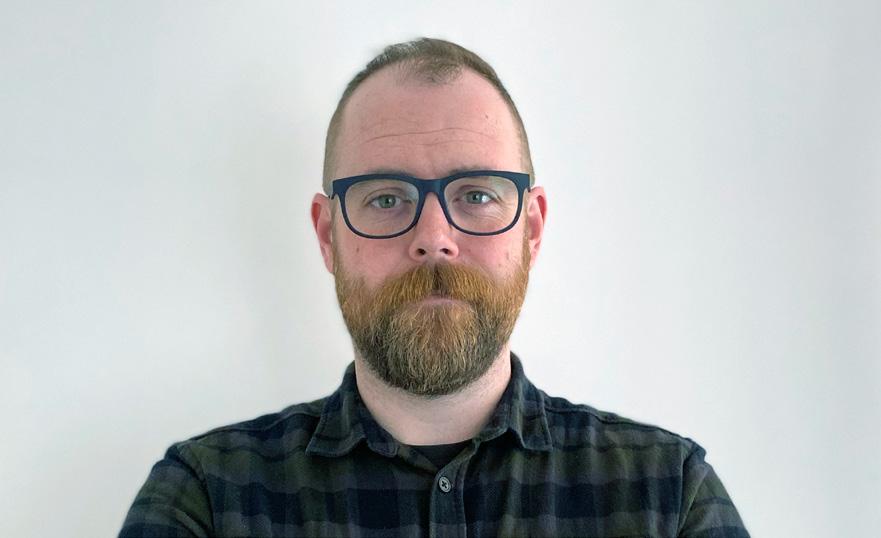
and curate vital opportunities to connect, meaning creative professionals and suppliers are no exception to those who can benefit from the BLE platform. No matter how experienced you are or what side of the immersive experience business you represent, there is always something new to learn and new brands and partners to connect with for the next big development.
What are the significant trends in licensing that are crossing/could cross over to LBE?
BEN: The immersive experiences offered by LBE are just beginning to gain momentum. The technology, creative approach and consumer engagement inherent to this platform are evolving rapidly. There is growing interest in creatively produced hybrid experiences, such as how AI and VR can enhance immersive experiences worldwide. On the other hand, licensed back-to-nature initiatives that bring families together have also shown great success.
From exploring the LBE market, I have learned that memories make an experience genuinely impactful. Experience engineers know this well, but brands can leverage this by creating engaging connections with consumers through intellectual property licensing.
Another trend gaining traction is the potential of location-based entertainment at retail. Retailers increasingly seek immersive experiences to drive foot traffic and engage consumers in ways that
26
Ella Haynes
inparkmagazine.com
Ben Roberts
traditional retail cannot. This presents an opportunity for brands to leverage their intellectual property to create unique and memorable experiences that generate revenue and strengthen brand loyalty.
So, the creative development of the LBE business is driving new opportunities for the market to grow, but there is also a successful and equally exciting increase in intellectual property licensing that is driving the connection with the guest.
For those who don’t know the organization, can you tell us about the Global Licensing Group and how it fits with License Global, Licensing International, and Informa Markets?
BEN: The Global Licensing Group is a collective of brands within Informa Markets – including Brand Licensing Europe, Licensing Expo in Vegas, the Brand & Licensing Innovation Summit (B&LIS), France Licensing Day, Licensing for Retail Day, Licensing Expo China and the dedicated media and insights platform, License Global.
As a collective, the Global Licensing Group is the world’s only media and events platform devoted exclusively to the global brand licensing industry. We work closely with industry body Licensing International as a long-standing partner to ensure best practices and that every brand is developed in line with the trajectory of the industry and community we cater to.
Does BLE differ in significant ways from its sister show in Las Vegas, Licensing Expo?
BEN: It does, yes, especially when it comes to where an IP’s rights are held. So, you might see the same exhibitor at BLE and Licensing Expo, but one may only deal with IP rights in North America, while the other has rights across Europe.
Expo is our flagship, global event where we see key representatives from all regions with a particular concentration from North America, LATAM & Asia as well as senior decisionmakers from the UK & Europe. BLE concentrates on panEuropean licensing – i.e. bringing the industry together to do business with, or in, Europe. Attendees are mainly from the UK, Western and Eastern Europe as well as senior decision makers from North America and LATAM.
What makes London an ideal setting for this event?
ELLA: London is such an exciting, vibrant, ever-evolving city and it’s the epicenter of so many brands, especially those touching on the LBE theme that I think London’s probably the most advanced experience-led brand location in Europe. The UK is also the 2nd biggest licensing market globally. It’s accessible for the rest of Europe – and for visitors from further afield, too – it’s really easy for everyone to get to London and also to have a great experience while they are in town. •

OCT 12+19+26+NOV 2: INTEGRATED STORYTELLING FUNDAMENTALS NOV 9+23+30+DEC 7: AI STRATEGIES FOR STORY EXPERIENCE DESIGN JAN 4+11+18+25: STORYTELLING WITHOUT WORDS All courses consist of live, interactive sessions with limited seats Advance your story experience design skills with our popular online courses studio · live · academy Begin your journey on ADVENTURELAB.ACADEMY by signing up for our complimentary introduction webinar and Q&A on SEP 21 Yourcourse instructor KlausSommer Paulsenisan IAAPAExpoEurope2023speaker




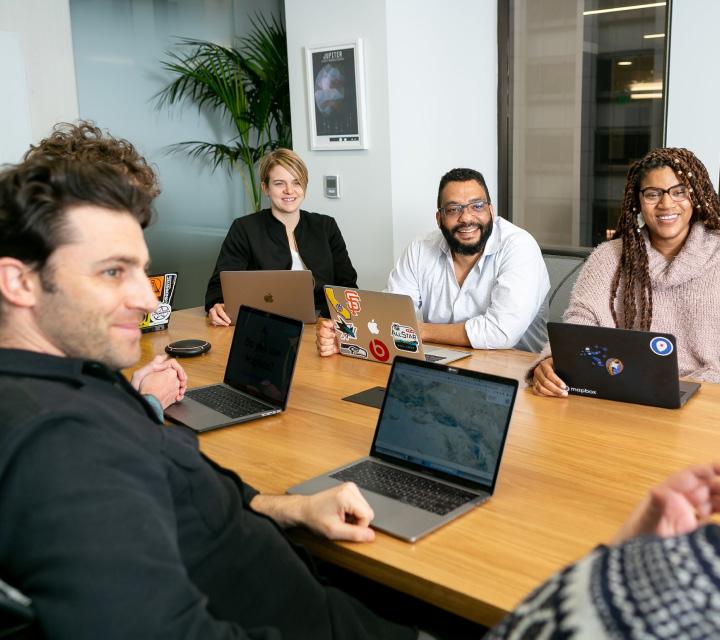
Celebrating the community and the zoo
Three new projects by PGAV Destinations at the San Antonio Zoo pay tribute to the city’s culture and the Zoo’s history
by Joe Kleiman
After investing close to $100 million over the past ten years on new exhibits, San Antonio Zoo is spending an additional $60M on Phase 1 of a long-term master plan, “Generation Zoo,” for which PGAV Destinations is providing architectural and design services.
Phase 1 of the new master plan consists of a newly reimagined entrance plaza (scheduled to open in November 2023) and a gorilla habitat and events center (both to open in 2025). These three projects pay homage to the zoo’s history and its ties with the community of San Antonio, while creating forwardthinking environments in line with today’s best practices in terms of designing for optimal guest experience, animal stewardship and operations.

This is a zoo power pairing. PGAV Destinations is an industry leader in master planning and habitat design for the zoo and
aquarium community, including most of the SeaWorld parks - making them an ideal choice to help realize the new vision for the Zoo under the leadership of President and CEO Tim Morrow, who joined from SeaWorld San Antonio in 2014.
Recent projects of PGAV Destinations either completed or in development include the expansion of the Clearwater Marine Aquarium, Expedition Africa, the largest expansion in the history of the Oklahoma City Zoo, and the newly opened SeaWorld Yas Island, Abu Dhabi, which, along with Chimelong Ocean Kingdom and the Georgia Aquarium before it, makes PGAV the record setter for world’s largest multispecies aquariums.
In addition to his current position with San Antonio Zoo, preceded by nearly 20 years with SeaWorld San Antonio, Tim Morrow has served in a number of organizations dedicated
30
inparkmagazine.com
The zoo’s new entrance pays tribute to San Antonio’s Hispanic heritage and showcases multiple works by local artists. All images courtesy PGAV Destinations
to tourism and conservation. Currently, Tim sits on the Executive Board for the International Elephant Foundation as its Past President and on the board for Texas Travel Alliance as Treasurer and Officer. Additionally, he sits on the boards for Visit San Antonio, San Antonio Visitor Alliance, UTSA Alumni Association, Young Presidents Organization’s San Antonio Chapter, Zoo Conservation Outreach Group, San Antonio Chamber of Commerce, San Antonio Sports, International Iguana Foundation, and the Urban Outreach Advisory Committee for the Texas Parks and Wildlife Department. He established a longstanding relationship with PGAV Destinations while part of the teams collaborating on such projects as Discovery Cove and the Aquatica animal-based waterparks. When COVID-19 shut down zoos and aquariums throughout the country, under Morrow’s leadership, San Antonio Zoo was one of the first to reopen, introducing the concept of the “drive-thru zoo” where visitors drove through the park in their own vehicles on a route that provided optimal viewing while keeping safe distances between visitors, staff, and animals.
San Antonio Zoo’s origins date back to 1914 and, in 1929, it emerged as an early leader in cageless animal exhibits. Today the 56-acre Zoo, which had an attendance of one million in 2022, houses some 3,500 animals representing more than 800 species. It is considered the top zoo in Texas and one of the best in the US. This AZA-accredited Zoo has been celebrated for its conservation efforts and high standards of animal care.
San Antonio flair
The new entry plaza, the first part of Phase 1, will celebrate the diverse cultures of the community and the architecture of the town’s Hispanic heritage. This turnstile-free entry will streamline and modernize the people flow, eliminating past inconveniences of the old 1950s entrance and complementing - in both aesthetics and operational value - the new parking garage erected in 2021 next to the Will Smith Zoo School. (The five-story, 650-space garage has been described by Morrow as “the most beautiful parking garage on the planet that further amplifies the conservation work we do locally, regionally, and around the world.”)
“The entrance plaza design has a real San Antonio flair, and there’s a lot of art from local artists,” says Tom Marschner, Vice President of PGAV Destinations, who led the master planning for the Zoo. “The Zoo handled the collaboration with the city’s Department of Arts and Culture with those artists and we determined the best locations to place them,” adds Marschner. In addition to sculptures, there will be seven areas where local artists will be able to present paintings, murals, and similar artwork on the exteriors of buildings.
“The theming for the entrance plaza is colorful and bright. It absolutely pops of color,” says Andrew Schumacher, PGAV’s architectural designer on Phase 1. “There are lots of teals and purples, and the buildings are made of natural limestone [both a local building material and a reference to the zoo’s location

31 inparkmagazine.com
Congo Falls will feature multiple ways to view the park’s gorilla troop.
in a former limestone quarry] and stucco with clay roof tiles.” A retail location at the entrance has been expanded and a new event space has been added. “The entrance itself flanks two buildings,” adds Schumacher, “and the zoo needed additional event space for use after hours, so there’s a stairway or elevator that can be taken up to the roof, and the space is connected by a bridge over the entrance between the two rooftops.”
To better facilitate traffic flow, ticket booths have been eliminated. Admission media are now online or can be purchased via interactive ticketing kiosks. There will also be a concierge desk available to assist guests who have questions regarding their tickets or passes. The new construction for the entrance also consolidates park offices into a single location. Throughout the entrance plaza, colorful banners (papal picado) will fly overhead, similar to the paper banners often found in Mexican marketplaces. Each will feature a latticework animal, bringing a kinetic feeling to the plaza. “The papel picado represents the flavor and feel of San Antonio and the Zoo,” says Morrow.
Mopie and the Monkey House
The focal point of the new entrance plaza will be a celebration of animals and a nod to the zoo’s history, with sculptures of butterflies flying over a giant bronze gorilla sculpture by local artist Bob Guelich. The Zoo is also in discussions with Gillie and Marc Schattner for another gorilla sculpture at the entrance to Congo Falls, the new gorilla habitat (another Schattner sculpture at the zoo is the 17-foot tall “The Last Three,” which pays tribute to the last remaining white rhinos). Both sculptures will pay homage to the zoo’s last gorilla, Mopie and the species’ return. Thirty years ago, Mopie relocated to the Smithsonian’s National Zoo, and until now, the San Antonio Zoo has been without gorillas.
Mopie’s former habitat had been at the zoo entrance and is now a lemur habitat with a netted walkway that allows the lemurs to travel overhead, a modern exhibit and enrichment technique that creates visual spectacle for visitors and animals alike while it makes use of all available space. “We try to enrich our animals’ and our guests’ experiences however we can,” says Morrow. “For older zoos, especially those with limited space, we look at building up. How can we expand the habitats that way? We did it with our jaguars. The jaguars have an enclosed
pathway that leads through an aviary to the howler monkey habitats. They can see the birds and the monkeys, and the birds and the monkeys can see them. Now the lemurs will be able to see guests and guests can see them in a new way.”
Beginning in 1914 as a wildlife collection in Brackenridge Park, in 1929 the San Antonio Zoo unveiled some of the first cageless zoo habitats with the Barless Bear Terraces and Primate Paradise, known by locals as “Monkey Island.” Most monkeys, however, did reside in cages surrounding the Monkey House, a historic stone structure built as a government WPA project during the Great Depression in 1936. Monkeys were removed from the structure a decade ago when the Zoo began redefining its zones on a bio-geographical basis, moving to either South American and African zones, based on the species’ place of origin.
The Monkey House has been repurposed to play a major role in the new entrance plaza. What housed empty cages on one side and storage on the other is being transformed into a central location for guest services, including stroller rental, some retail, a café, and a wraparound bar. The redesign also includes improved comfort facilities. “With the renovation of the Monkey House, we’re adding two large restrooms, two universal changing stations, and a nursing mother’s room,” notes Morrow, (who has two children himself), reflecting the consistent attention to detail and awareness of the needs of families that are essential within the bigger vision.
“We worked closely with the Texas Historical Commission,” says Schumacher, “on what modifications could be done with the Monkey House. We had to restore the windows and clean the stone walls. It’s a protected WPA structure, but now we’re recreating it for a new use.”
Mopie’s legacy
In 2018, the San Antonio Zoo approached PGAV Destinations to develop the “Generation Zoo” master plan. “We are 109 years old. The name really represents the generations of families and visitors that have come over time,” explains Morrow, “and their memories coming with their parents, grandparents, children, grandchildren and extended families. It also speaks to the next 100 years of growth, the future generations that will come.” The design studio created four pieces of concept art, each portraying



32
inparkmagazine.com
Tim Morrow Andrew Schumacher Tom Marschner
a unique habitat - tropical aviary, country farm, riverfront, and caves. But when guest surveys were completed, one animal always appeared at the top of the list: gorillas.
On the opposite side of the Zoo, currently unused at the base of the stone quarry cliffs, gorillas will soon be returning, to an area called Congo Falls. “We’ve been working on this for two years,” shares Morrow. Mopie was such an integral part of the zoo and a part of the city, and our guests have asked for decades when gorillas would be returning, and Congo Falls was the name of our original gorilla habitat at the entrance. So with our new design, we use the new entrance to set the stage for the zoo, but the gorillas are our anchor attraction. It really is an incredible attraction to show the direction in which the Zoo is moving. San Antonio and St. Louis were the first zoos to present cageless exhibits back in the 1930s. Now we’re taking it to the next level.”
“Similar to the Monkey House,” says Schumacher, “the needs of current design trends outgrew the space.” As part of their research, PGAV Destinations’ design team visited the gorilla habitats at the Houston Zoo and the Omaha Zoo, meeting with zookeepers and discussing the latest AZA standards.
In addition to a veterinary center, indoor housing, and interpretive areas for guests, the area is designed like a trail through a natural habitat, with numerous ways for guests to view and engage with gorillas and vice versa.

“For safety and health reasons, we had to have a separation between gorillas and guests, but still make sure the guests are
immersed in the viewing experience. In some areas of the habitat, the experience is up close with only glass separating; in other areas, they’re walking along trails adjacent to the gorillas with separating elements between them. We want to provide as much flexibility as possible in the experience and part of that is incorporating trails. In one area, guests are enclosed in mesh. The design mitigates the risk of guests entering the enclosure.” Within the gorilla habitat, guests will also be able to view the animals above them through a glass ceiling or through bubble windows, which allow them to enter the habitat itself.
As with its other animals, species preservation is of utmost importance - the Zoo is heavily vested in conservation efforts for native Texas and Mexican species, along with a conservation initiative with indigenous peoples of the Amazon, among other national and international projects. As part of those conservation efforts, the Zoo’s new gorillas were selected from other zoos based on genetic variability as per the Association of Zoos & Aquariums’ (AZA) Species Survival Plan.
A window on Africa and San Antonio
High atop the quarry walls will sit the new events center, capable of hosting up to 500 guests for a single event, with the capability to be broken down into smaller enclosed spaces. The space is being funded completely by private donations. “We are using lots of natural materials, lots of woods,” says Schumacher. The color scheme is neutral, so it makes it easy to provide flexibility in the space for any kind of event. The pillars mimic trees; there’s a grassy, naturalistic pattern to it, with little silhouettes of animals as well.”
33 inparkmagazine.com
Gorillas will visit with guests at the Zoo’s new event center by climbing a six-story tower.
The use of a design scheme for the event facility incorporating natural and animal motifs is fitting, considering its juxtaposition with the Zoo habitats below. Because of the placement of habitats on the embankment that leads up to the foot of the quarry cliff, through a giant viewing window, event center attendees will see gorillas and lions in the foreground, with the Zoo’s African savannah, including its rhinos and hippos, beyond, and in the distance, the skyline of downtown San Antonio. Divided into two buildings, the central outdoor plaza of the events center will be highlighted by a distinct feature unique to the park – Silverback Peak [working title]. This six-story climbing tower rises from the gorilla habitat below and events center guests will be able to come eye-to-eye with members of the Zoo’s gorilla troop at the top, separated only by a layer of glass.

Elephants ahead
The park for many years was home to Lucky, an older lone Asian elephant. Morrow worked out a deal with Feld Entertainment for two retired female elephants from the Ringling Bros. Circus to join Lucky. The endeavor succeeded and the three lived together for a number of years, known collectively as “The Golden Girls.” With the passing of Lucky
and one of the Ringling elephants, the decision was made to send the remaining Golden Girl to an elephant sanctuary.
“But the elephants are returning,” says Morrow. “Our next phase is going to involve returning Asian elephants to the Zoo.” Undeveloped zoo property on the other side of the freeway, behind the parking garage and the Zoo School will become the Zoo’s Asian district, with the elephants being the main draw.
“We have a lot we want to develop,” says Morrow. “Our Zoo School has a waiting list of 8,000 potential students. We have an opportunity to expand that, maybe even statewide or on a national level. We’re determining what that can look like, if it’s a private or public endeavor, and what types of partners, like universities, we might want to bring onboard.” Also in the works is a safari park. Morrow recently visited zoos in St. Louis and Omaha to see firsthand their concepts for a second, more open campus.
“But first, we finish and open Phase 1,” Morrow shares, “with the entrance plaza, events center, and gorillas. Then we’ll be in a good spot to approach our donors for the next phases of our evolution.” •
34
inparkmagazine.com
San Antonio Zoo was one of the first zoos to offer cageless exhibits. The new Congo Falls takes that one step further by placing guests in the middle of the gorilla habitat.
Complete range of projectors
Built-in warping and blending
Projection software tools
Image processing
Show control and content management
Switchers and AV distribution
Extended warranties and support
Partner: Planetarios Digitales

Explore our solutions:
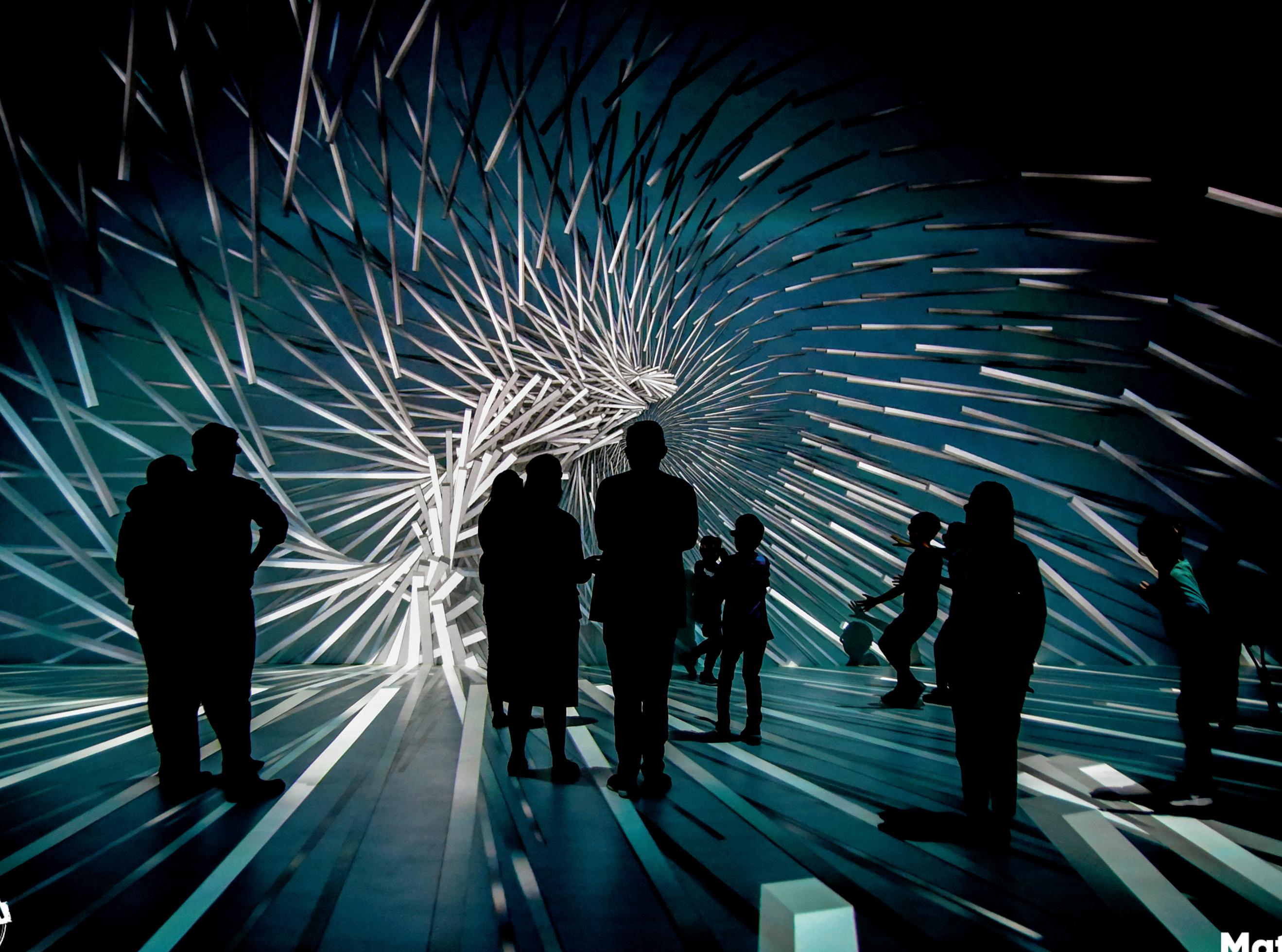
christiedigital.com/completeAV IMMERSIVE EXPERIENCES. AND THE SMART TECH THAT POWERS THEM.
Image: Cubo Negro 8K, Materia Museum © Ars Electronica Solutions/Sinaloa Science Centre
Making the move to cashless
How Connect&GO can make operations easier with RFID

 by James Careless
by James Careless
Since launching a decade ago, Connect&GO’s RFID-based (radio frequency identification) technology has made end-to-end, streamlined, cashless operations possible at a wide range of visitor attractions and venues. “We started in the events space with RFID wristbands and modules for access control, cashless and experiential activations with over 800 implementations worldwide, including the Super Bowl, SXSW Festival and even the Olympics,” says Tara Morandi, Connect&GO’s Senior Vice President of Sales and Marketing. “But that was only the beginning. Our technology has evolved to become a true all-in-one platform that offers the attractions industry a robust solution for managing eCommerce, pointof-sale, access control, cashless and more.” Having specialized in marketing and ticketing since 2007, Morandi knows her industry and her competitors.
The all-in-one platform Morandi is referring to is the company’s flagship product, their Konnect attractions management platform used by waterparks, family entertainment centers, zoos & aquariums, and attractions around the world. The growing list of clients that have adopted their RFID solutions include Roaring Springs Waterpark and Wahooz Family Fun Zone in Meridian, Idaho; Splashway
Waterpark & Campground in Sheridan, Texas; Playland in Rye, New York, Wild Water Adventure Park in Clovis, California, and several clients in Quebec, including Zoo De Granby and Super Aqua Club. “This year Connect&GO is on track to surpass $250 million in transactions, which is up from $100 million in 2022, and 10 million tickets sold through our platform by the end of 2023,” says Morandi.
The Konnect platform uniquely centralizes all guest data and transactions into proprietary Virtual Wallets which are stored on RFID media. These credit card-backed wallets are created for guests when they buy their tickets or season passes, and are assigned to their RFID wearables, cards and/or mobile devices to enable seamless access and cashless purchasing throughout an attraction.
Konnect Mobile and the benefits of integrated cashless systems
By accelerating gate admissions and onsite sales, Connect&GO has delivered benefits to park operators. Now the company is taking this ease of operation to the next level, through its upgraded Konnect Mobile point-of-sale (POS). These wireless mobile units allow operators to sell admissions, activate
36
Attractions
to
and RFID technology to help simplify operations and drive growth. All photos courtesy Connect&GO inparkmagazine.com
are turning
Connect&GO’s integrated platform
wristbands and fulfill web orders from any location in their park.
“Our Konnect Mobile unit isn’t necessarily new in our space, but it is much more intuitive and the ease of use has improved,” says Megan Fulbright, Connect&GO’s Senior Business Development Director, whose background includes 22 years in operations with Six Flags Hurricane Harbor (Arlington, TX). “It has been enhanced to manage ticket sales, ecommerce transaction redemptions, wristband allotments, single ride sales and/or cashless.”


Connect&GO’s growth in the attractions market signals a shift in thinking on the part of operators. “For far too long, the attractions industry has been stuck with separate legacy systems to manage a wide range of their operational needs,” says Morandi. “Now we’re coming to a point where operators are starting to realize there is no reason why they should need to have 12 separate systems that don’t communicate with one another. It leads to a fragmented guest experience and keeps data siloed and difficult to access, preventing them from growing their business.”
Using an integrated platform such as Konnect simplifies tasks such as adjusting prices and procedures, unlike less-flexible legacy systems. A case in point: “Recently when we were onboarding a new client, she told us that one of the reasons they were switching vendors was because she was tired of having to drive back across town anytime she needed to make a pricing change, because she needed to reboot the servers after hours for the change,” Morandi says. “With our fully-hosted system, she was excited that she could make a pricing change from anywhere and it would go live right away!”
The Konnect all-in-one platform married to RFID bracelets, cards, and mobile devices also helps guests to stay organized, which contributes to a better experience. “It’s confusing to have to juggle different tickets, vouchers and codes for everything, especially if you have kids to manage,” says Morandi. “As a
mom of two girls myself, the less I have to keep track of when we’re out, the better. With an integrated system and cashless technology, guests can load funds directly onto wristbands for each member of their family, and simply tap to access or pay throughout the facility. They can also access their tickets, benefits, arcade games tokens and cashless funds to purchase items at restaurants, retail shops and beyond. Reducing other friction points like long lines with our self-serve kiosks, Konnect mobile POS and integrated locker rentals, helps make guests enjoy their visit even more.”
Embracing cashless
That many in the attractions sector are now embracing integrated cashless/sales management systems represents a shift in overall business management.
“I’ve been in this industry for over 15 years and technology has always been a hard thing to embrace for operators,” Morandi says. “With bigger problems like staffing shortages, training, weather, and safety to worry about, it hasn’t always been a top priority. But now operators are starting to understand that technology can actually help alleviate some of those problems. Short-staffed? Utilize self-service kiosks and mobile point of sale units to get guests out of line and through the front gates faster. Allow guests to pre-purchase food and beverage items, parking and luxury cabanas all from the comfort of home using an intuitive ecommerce experience. After all, the more you can reduce the need for a staff touchpoint, the more guests (and Moms like me) will appreciate it.”
“I am finding that everyone from the general manager all the way down to the front gate operator is seeing the major benefits of updated technology,” says Fulbright. “I myself came from a legacy system where I needed to pull information from multiple sources to get to the information I needed. Once I have been able to show several of my colleagues in the industry how simple it is to garner information needed from a single source like Konnect, I have won their attention.”
37 inparkmagazine.com
Megan Fulbright Tara Morandi
The fact that Konnect is flexible and easy to work with is also changing operator attitudes. “Operations changes from day to day based on so many factors: staffing, weather, guest attendance, and guests’ attitudes,” Fulbright observes. “Our Konnect platform allows operators to adapt to the tide. As well, many of them have witnessed my comfort with it, which serves as an encouragement to most. And after all, today’s frontline staff and other young professionals are very comfortable with the technology, as long as it is intuitive and easy to learn.”
The fact that the Konnect cashless system supports a better guest experience is also helping to change minds. Satisfied guests are more likely to come back, and spend money every time they do. “As a mom, I love the ease of the cashless system,” says Fulbright. “I can send my teenager to the parks and see what he is spending and how he is spending it. I can add or take away at the drop of a hat. I imagine that is how other guests see this. Kiosks, integrated locker systems and the cashless opportunities put fun at your fingertips or your wrist while reducing friction. I have seen it with my own eyes!”
Making the transition
Benefits aside, “switching technology or even updating technology is a headache. No one wants to make a huge leap,”
Fulbright admits. “It is scary and overwhelming. But the benefits are worth it, especially because our system is easy to train on, cloud-based and good for the bottom line. It gives you real-time data and grows with you - once the system is in place it can live there and evolve as your park does!”
Operators can transition incrementally. “Testing out cashless before committing to the whole system is a great place to start,” says Fulbright.
What’s coming next? “We are constantly working to evolve our solution based on client feedback and what the market needs for attractions,” says Morandi. “Our Chorus Pro integration will be ready this fall and we are also developing our AttendX platform, an AI solution we are launching with our partner MoovAI that provides traffic prediction and dynamic pricing models based on estimated attendance and weather patterns.”
For more information, Connect&GO invites you to book a demo at IAAPA Expo Europe or Orlando via their website, www.connectngo.com •

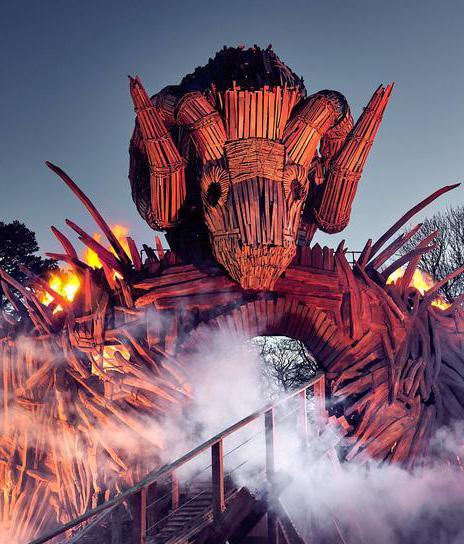


38
Connect&GO’s self-service kiosk in action at Wahooz Family Fun Zone in Meridian, ID.
inparkmagazine.com
Using Konnect mobile point-of-sale, operators can sell products, validate RFID wristbands and process cashless reloads anywhere in their park.


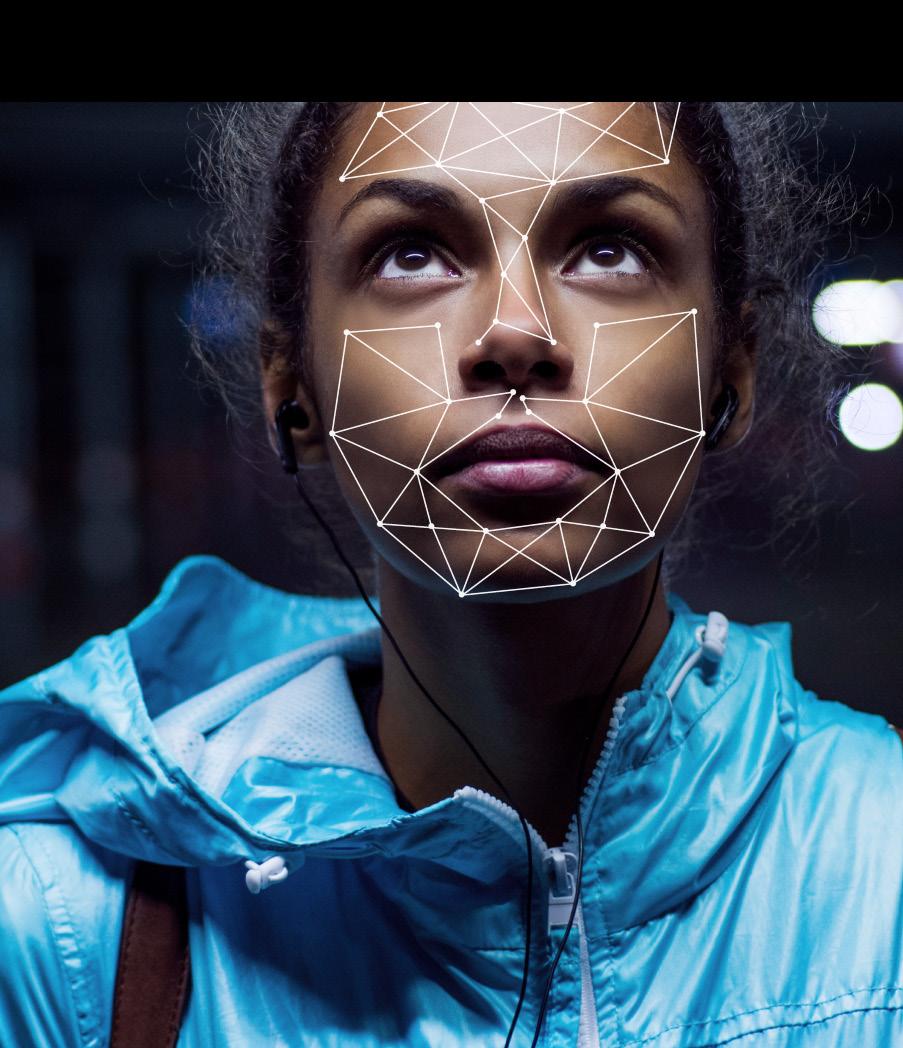




39 inparkmagazine.com COMPLEX AV GAMIFICATION ADVANCED TRACKING DARK RIDES PROJECTION MAPPING MOTION SIMULATORS SPECIALISED INTEGRATED SOLUTIONS WWW.HOLOVIS.COM MIDLANDS, UK ABU DHABI, UAE SHANGHAI, CHINA ORLANDO, USA
Design & development
Five UCF grad students create concepts for Alterface’s The Wander by Judith
Rubin
The Wander is an interactive technology developed by Alterface to support rich, immersive and non-linear experiences for education and entertainment in a wide range of indoor and outdoor venues. It was created to be an intuitive tool for designers, storytellers and world builders and is scalable.
To help demonstrate The Wander’s versatility and potential, Alterface and InPark recruited five students from the University of Central Florida (UCF) Themed Experience graduate programs, headed by Prof. Peter Weishar. These masters candidates, who are all currently employed in the field, were challenged to learn about The Wander and create viable, original concepts for its use in attractions.
From Alterface, information, feedback and guidance were provided to the students by Etienne Sainton (Product Manager), Stephane Bataille (CEO) and Laurence Beckers (Creative Director).
Sainton describes The Wander as “the first technology that ‘industrializes’ the creation of and manages the entire life of experiences, from design to implementation in a venue. It is a software tool to create and activate stories in the mind of designers.”
This exercise was organized and curated by InPark editor Judith Rubin. Heartfelt thanks to our student participants, whose names and work appear below, and who are building careers in themed entertainment. Follow the links to see their portfolios.
For more information about the UCF masters programs in Themed Experience, visit: www.ucf.edu/degree/themed-experience-ms/
Projects using The Wander have been announced and we can expect more news of them in the near future. Find Alterface online at www.alterface.com, and visit their exhibit booth at IAAPA Expo this November. •
“We’re grateful for this collaboration that has not only showcased the students’ talents but also revealed how ‘The Wander’ can transform imagination into tangible, extraordinary realities!”
Stephane Battaille, CEO, Alterface

“I’ve been truly impressed by the inventive ideas the students came up with. I was the happy witness of their creative minds in action! The various outputs of their reflections highlight the real potential of ‘The Wander’ to give rise to unique and innovative concepts. In a way, it reinforces the notion that with the right tool, imagination knows no bounds!”
Laurence Beckers, Creative Director, Alterface


“Alterface generously shared their time, technology and knowledge with our students. It was an excellent educational opportunity. I learned a good deal too. The company is doing some fascinating and innovative work.”
Peter Weishar, Director of Themed Experience, Themed Experience MS Degree and MFA track, University of Central Florida
“It’s so fun to witness a new concept being embraced from fresh perspectives. The students from the University of Central Florida have truly brought forth various visions and ideas to effectively leverage technology for immersive experiences.”
Etienne Sainton, Product Manager, Alterface

40
inparkmagazine.com
EchoStone Experience
Mike Strong, project manager, Westview Productions LLC

mikewstrong@gmail.com
Story
Lore: A theme park was created above Radiance Hollow, a hidden realm where magical creatures tend EchoStones that flourish on the park’s joy. Our villain, Moonshadow, coveted the stones seeking power and control. The guests’ laughter and joy in the theme park above, combined with the EchoStone players in the park proves formidable. As guests immerse themselves, the EchoStones thrive, creating a glowing symphony of light throughout the park.
One significant challenge in thinking about creating a cohesive park-wide story is that theme park lands tend to have their own separate stories. However, I found it compelling that the Wander technology has the capacity to be used throughout a park as opposed to a single area. I conceived the EchoStones story lore to use the opportunity to weave the Wander into every facet of a theme park, with the potential to adapt to an overarching theme both digitally and physically. In the case of a destination park, the technology could follow guests back to their hotel rooms – and even to other parks.

In the physical park, guests can purchase an EchoStone of their own, which will vary in color and design, and can be worn as a necklace (or placed into other receptacles: headbands, water bottles, etc.). As guests progress through the park, the EchoStone will glow, pulse, or vibrate to alert them to possibilities for interactivity. Guests with EchoStones collect joy and fun throughout their day, which causes their personal EchoStones to glow brighter and unlock opportunities to use the magic stored within.
Further, there can be opportunities to connect a guest’s personal EchoStone to a ride vehicle or place it into a device (a wand, lantern, etc.) and allow them to explore and interact more seamlessly within a given land’s theme. The opportunity to continually update, upgrade, and create new stories digitally is endless. Mini-games and cooperative play are also possible and can continue to evolve with the park and its guests. •
41 inparkmagazine.com
| mikewstrong.com
Eleni Trapp, senior UX designer, Caesars Digital eleni.trapp@gmail.com | www.elenitrapp.com
Jump
into a land where exploration of the natural world becomes a personal adventure book. With the power of Wander, visitors can revolutionize how they explore the world’s natural wonders.
The Stardust storyline will guide guests through touchpoints of natural parks including visitor centers, iconic natural landmarks, campsites and trails to uncover stories left behind by previous travelers. Guests will collect Stardust by completing challenges such as photographing wildlife, finishing a hike, or engaging with educational checkpoints. The Stardust earned can be tracked using enhanced devices - such as walking sticks with built-in geolocation and compasses that prompt personalized pathways - to create meaningful connections between visitors and their surroundings.
As visitors gather Stardust, they contribute to the entire park’s storyline by unlocking additional chapters of stories which can be told through a variety of mediums. These stories can be
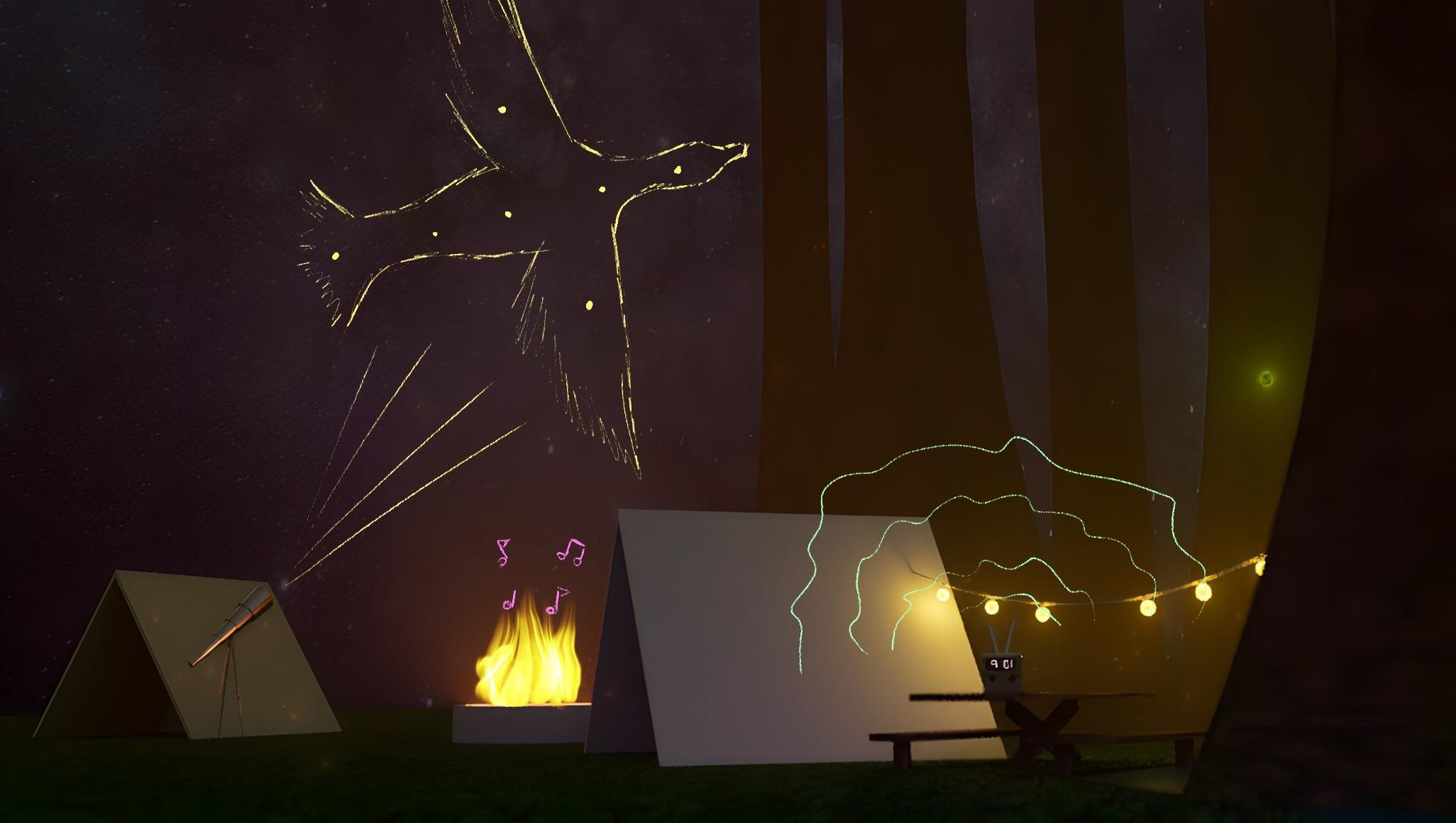
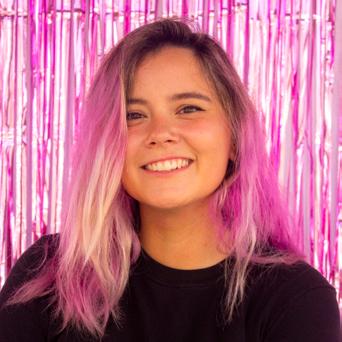
curated from the histories of the people who lived on the land, local legends and even the geological history of the park. A parkwide radio station serves to keep visitors informed while offering an additional avenue for sharing stories.
Stardust will truly come to life at night, as visitors settle into their campsites. Basic campsites transform into campfire storytelling hubs, where explorers gather around the flickering flames, to be swept away by rich history and legends. Aided by telescopes with AR overlays, the stories of constellations unlocked by guests with Stardust can play out in real time across the stars.
The Wander platform can be implemented to bring Stardust to a single park such as New York City’s Central Park - or expanded across a network of parks, such as the National Park System. With Stardust, visitors get to help write new chapters of a story where nature takes center stage. •
42 Stardust
Bonnie Sinclair
inparkmagazine.com
The Last Hallowish
Brittany Porthouse, Show Set Specialist, B Morrow Productions

TheLast HalloWish is a walkthrough, “choose your own adventure” game experience. Guests can help Halloween partygoers-turned-ghosts with their unfinished business, fulfill last wishes, and make new friends (or nemeses) in the process.
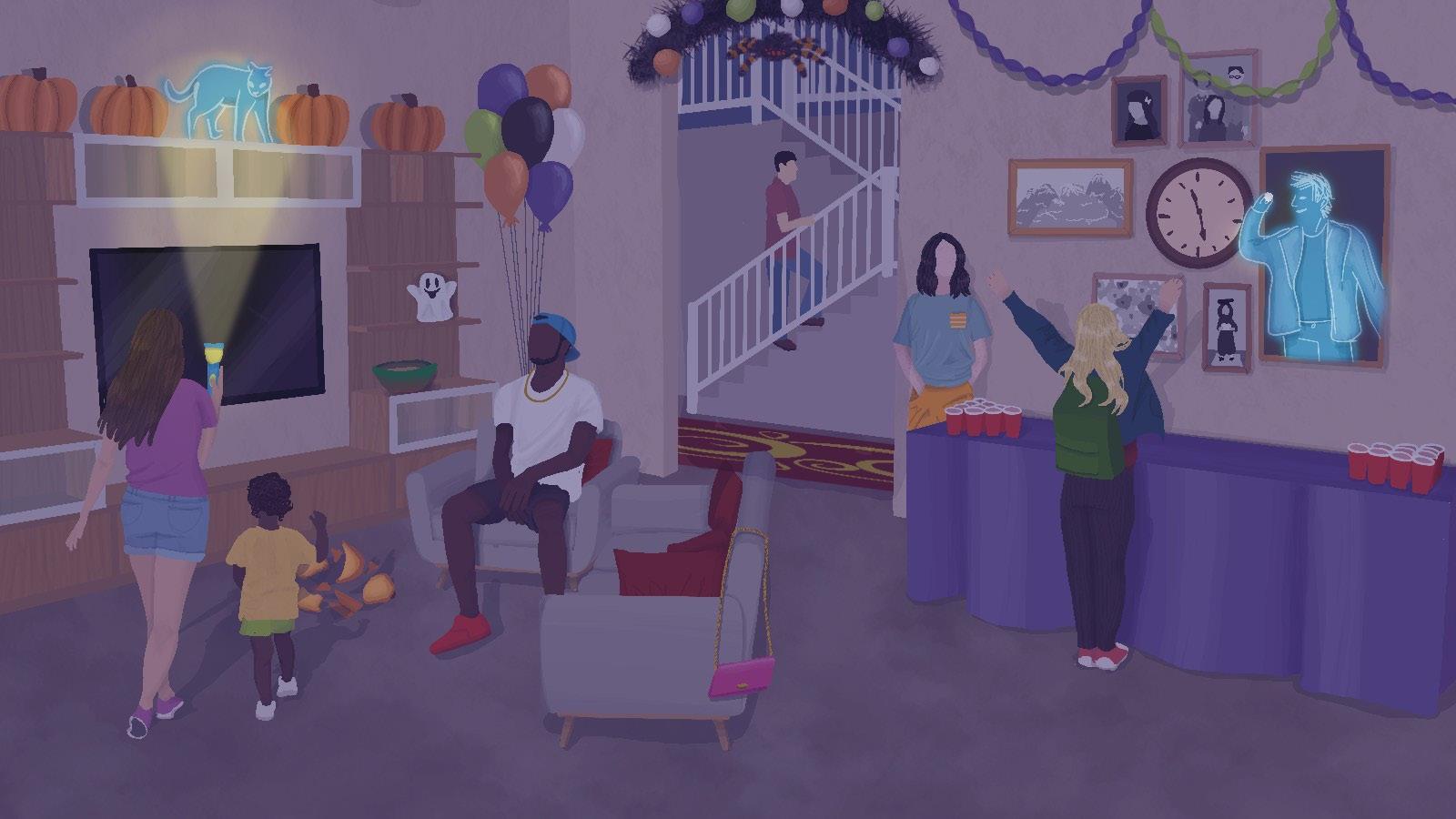
Backstory: Determined to make this year one that nobody could forget, Skylar Park decided to throw the biggest Halloween bash that Pine State University had ever seen. With her parents out of town for the weekend, she had free reign to turn their fancy house into the most creeptacular party. Unfortunately, a defect at the Ghostmallow factory turned the popular candy lethal, and after everyone ate them, none of these celebrants is the life of the party anymore!
Using their Wander-branded flashlights to cast light on paranormal activity, guests can discover interactions, games, and puzzles within the story. These may lead to a new quest (such as helping Stacy find her contacts), a necessary object (Fizz-O, Kirk’s drink of choice), or a game (beating Brad at fear pong, a cup game with a spooky twist).
Solving puzzles, beating games faster, or finding hidden details could lead to bonus knowledge to use in later activities – such as Andrew’s itching powder prank on Priya’s purse. If guests deliver Priya her purse without this knowledge, she may become upset…and subsequently “tell her friends.” Priya’s best friend Olivia, if approached by the aforementioned guests after The Itchy Incident, will react coldly and may give guests a different quest than other groups may receive from her.
This nighttime-focused venue has a quick-service food counter inside so guests can consume their favorite appetizers or beverages, just as at any other party. To allow younger audiences and families their own PG-rated fun during daytime hours, the experience has certain embedded props and storylines that can be activated. •
43 inparkmagazine.com
brittanyporthouse.com
brittanyporthouse@gmail.com |
Mysteries at the Zoo
Families
and children discover the breadth of fun to be had exploring the animal world with the implementation of the Wander technology as Mysteries at the Zoo. Combining elements of education and puzzle-solving into an intriguing adventure that leads them throughout the zoo, guests find themselves growing closer to the animals and their counterparts in the wild.
Penny Pigeon, a bird-ace detective, recruits guests to help solve mysteries among the animals. The experience uses dynamic signage, show set and interactive puzzles along with an ARcapable magnifying glass device for guests to use.
At the brown bears’ exhibit, their favorite honey is missing! The magnifying glass helps guests uncover clues leading to two possible culprits: badgers and skunks. Guests continue their investigation at the skunk and badger exhibits, then bring their findings to Penny’s Detective Agency.

In the finale, guests apply everything they’ve learned along the way to solve the mystery with Penny and interrogate the animal suspects, with assistance from the Wise Old Owl. Finding that the skunks have stolen the honey, the guests earn Zoo Detective badges. The skunks are asked not to steal again and promised that the zookeepers will share more honey with everyone.
A new mystery awaits guests each time they return. The experience is conceived as a scalable add-on, a permanent installation with elements in and near existing exhibits, and multiple signup kiosks. There are some updatable elements, such as dynamic signage and multiple finales. In addition to badges or stickers, zoos could have higher-tier awards for guests to earn, such as opportunities with the animals.
It is assumed that families and groups are working as a team to help the youngest. Mysteries at the Zoo could be a repeatable franchise, with the potential to be a connected adventure across multiple zoos. •

44
Bonnie Sinclair
a Zoo Detective!
| arianna.whitefamily.com
Become
Arianna White, senior show coordinator, Universal Creative Ariannawhite020@gmail.com
inparkmagazine.com
Wander-LUST
Brittany McChesney, Development Manager, EA Sports br932671@ucf.edu | bmccart.com

Onthe floating city of a cruise ship, guests have a myriad of ways to stay entertained. However, these events rarely coincide with the content of their cruise, and have no effect on the outcomes or rewards they achieve. Wander-LUST bridges this gap to make cruising a more immersive experience.
Utilizing region-specific theming and quests, Wander-LUST allows travelers to experience an integrated system of quests, rewards, and trip-planning services for their cruise vacation. With Wander, several pathways will be available to make the most of guests’ vacations in their own distinct style.

QUESTING - Wander adds another layer of adventure and storytelling to the vacation of a lifetime. The questing pathway lets guests sink into the story through entertainment and gamification.
DISCOVERABLE REWARDS - For guests with a hunger for discovery, this pathway is for those who want to score rewards without getting too deeply immersed in the story. An achievement-focused playthrough will help them earn the best bonuses and deals onboard.
TRIP PLANNER - For guests who want an intuitive itinerary experience, this pathway lets Wander do the planning. Wander will guide guests based on their preferences, age, and logged experiences.
EXAMPLE: For childless adults or single travelers on a Scandinavian cruise, events may skew more physically demanding and adventurous, with quests or discoverable rewards to make them eligible for feasting in Valhalla. For families, events include quests that allow for fun together and separately, all to please Njord, the Norse god of the wind and sea.
Wander-LUST is family-friendly, offering tailored rewards based on player profiles and preferences. Progress for players is tracked via mobile app and an RFID-enabled pin for “check-in” at Wander-LUST stations. This hardware requirement limits installation to new or pre-commissioned ships, or a retrofit during an extensive overhaul. •
45 inparkmagazine.com
Helping yourself
Semnox streamlines the future of self-service in leisure venues
 by Tammie Richards
by Tammie Richards
Digital management tools to interface with guest attendees’ smartphones have become industry standard for successful entertainment attractions operators around the globe, with the possible offerings expanding user support into a dozenplus concentrations this past decade and a half. Disparate core systems have landed on the scene in this timeframe for guest e-ticketing, cashless ordering systems that automatically convert currencies, helpful reservation protocols that limit times standing in queue lines, interactive prize redemption kiosks, and a host of other self-servicing technologies to finetune one’s live entertainment experience.
In its ongoing mission to bring cost-effective, holistic solutions and quality service to their clients operating family entertainment centers, waterparks and theme parks, it was an intuitive step for the brains at Semnox to streamline these user systems into a single, cohesive package. For more details, we spoke to Semnox Business Head - Parks, Mr. Ashish K-S.
How did you get started? What inspired Semnox to deliver all-in-one technology systems for high value?
The history of Semnox started with a request for our founder, Iqbal, to help with software for an indoor gaming center in 2007. (Iqbal Mohammad is now Chairman, Semnox Solutions
Private Limited.) At that time, all machines in these facilities were coin-operated and everything was very manual. Iqbal’s vision, even at that early stage, was to advance the most futuristic technology, identifying the use for an RFID contactless solution that would ultimately be adopted by all. Semnox pioneered with RFID even 15 years back, and our solutions continue to be competitive today.
From there, the natural progression was to develop ticketing solutions. We realized that if operators were to gain the full benefits, it had to be a single (source), venue-wide solution. There were so many piecemeal solutions at the time, and for each venue to support its own complex IT landscape was both costly and difficult to support for the management and operations teams. There was also an inherent lack of ownership of the various problems, with different systems in place and support teams involved.
That is why we built a system based on a variety of modulesto have a cohesive and complete platform that can do the basic functions necessary for operating a venue. And we quickly saw the benefits our clients were experiencing, and how very appreciative they were of our improvements, for their bottom line.
46
inparkmagazine.com
At Lembang Zoo (Indonesia), turnstiles integrated with the ticketing system provides automated access control. Photo courtesy Semnox
What makes Semnox solutions unique and competitive?
There are multiple factors that differentiate Semnox. The main factor is the completeness, in terms of the modules and functions our solution can provide, uniquely designed to cater to the unique needs of both indoor FECs and ticketed attractions. We provide both hardware and software solutions that can integrate well with the different functions of the venue - like doors and gates for access control, game readers for the arcade machines, and self-service kiosks to secure ticketing, rent lockers and reserve cabanas. Our solution is rounded out by our e-commerce suite. Clients can offer products, promotions, and reservations 24/7 and create their own QR codes that link back to these fully integrated revenue streams to incorporate in their own advertising or external opportunities.
There are multiple solutions such as the integrated mobile app, which we believe is a unique out-of-the-box feature. It can support easy interaction with the guests via push notifications for new offers and ensure guests have all their key information in hand.
We also have the integrated web inventory module which supports F&B and Retail sales and back-office operations like creating interstore requisitions, purchase orders, receipts and multi-site stock control options.
Inventory also has advanced features such as recipe management, helping customers gain a very good control in the quantity and quality of food preparation and automated cost reporting.

How does combining multiple self-service technologies improve guest user experience? And for the team users?
Self-service tech allows guests to advance transactions as they like, at their convenience. Guests don’t have to stand in line, or be on call to get a rep, nor make instant decisions about what tickets to buy and what slots etc. Rather, they can select these options within a mobile app, go online to the venue’s website, or walk up to an onsite kiosk to manage their transactions: see where they’ve spent, what tickets are booked, what loyalty points they have available on their accounts, etc.
This support frees up guests’ time to enjoy themselves at the venue in the way they intended, resulting in a better experience and higher perceived value. Likewise, for the venue team, the approach reduces much of the guests’ dependency on them, giving them more time to do more productive work that can enhance the guest experience in other areas. All this naturally improves the overall guest experience.
What current trends have inspired new technology solutions from your team?
Our main focus is on the need for more and more self-service options, whether offered via online sales, through the app or
at self-service kiosks. Also, we have seen a recent push for subscription offerings, which can equate to a sustained revenue for operators. We already offer these in-demand solutions, but we are strengthening them so every operation can be available to an attraction’s guests, directly eliminating the need for them to call on team members or stand in line anywhere.
Another feature we are working on currently is to help move away from physical tickets and into a place where you have pretty much everything else happening – on your phone. We already have the go-ahead on our Google wallet and are working to release an additional wallet solution. Once a customer buys their ticket, they can save it to their wallet and then use that wallet to smoothly tap and enter at the gates.
Did your offerings change in relation to the pandemic?
The pandemic made venues think more seriously about technology. Many saw the need to expand their investment in contactless technology and automation, and our team was working overtime to fulfill the sudden increase in demand. The good thing was that we were already ahead of the curve – we already had the technology platform and solutions to meet these needs, which made things a bit easier for us to manage.
How does an integrated Digital Waiver Management system help boost repeat visits?
In today’s digital world, nobody likes having to fill out paper forms each time they visit. It delays the time required for entry, automatically and directly impacting the customer experience. Plus, the effort of storing and managing these forms for the venue can be challenging. Customers and operators should not have to go through this.
47 inparkmagazine.com
Mr. Ashish K S, Business Head – Parks
But with the digital waiver, once all the form requirements are entered it is readily available every time and the data is able to automatically be verified at the point of sale (POS). It is available to be completed on any channel: online, kiosk, POS or handheld tablet, based on customers’ convenience, and then stored.


Operators can also set the waiver validity to cover a specific date or timeframe. With Semnox, an added advantage from some of the other digital waiver solutions is that our waivers are directly integrated within the transactions themselves. So, there is a proper check against the specific activity, to ensure the waiver signed and on file is validated for a particular booking.
Can you tell us about the new patent Semnox announced this past spring, and how it complements your other offerings?
Our latest patent for our RFID Tag Roaming Solution enhances not only the guest experience but the location operations team’s as well. Enabling account data to synchronize with a cloud database creates a secure environment for multi-store organizations to effectively manage and analyze their business. It allows for guests to seamlessly move from one venue to another without any lag or delay in their experience, which alleviates frustration for both guests and the on-site operations team. The way we built the Tag Roaming Solution also makes it scalable based on the client’s needs; useful to single locations with multiple in-house vendors, small-band stores, or corporations with hundreds of stores. With each enhancement to our system that we take on, we look to accelerate not only our system but operational functionality for our current clients, future clients, and the industry.
What potential future expansion modules can we expect in the future?
We believe our existing platform itself offers one of the most advanced and comprehensive catalog of features and functionalities available anywhere in the market. But we have always been driven by a need for relentless innovation and to make what we have created even better.
With the current work towards adding wallet functionality –where guests can add tickets to their Apple or Google wallets and then use them across the venue – we will eliminate the need for any physical tags. Similarly, we are also enhancing our F&B offering to incorporate online food ordering, POS scanning for order options, etc., so guests can plan out their whole day in advance or take advantage of self-service offerings onsite.
Our mobile App and POS system is also being completely reimagined to newly make the UI a more modern experience that is cloud focused. In the longer term, we are also enhancing our digital waiver and maintenance modules with new best-of-class features, to best partner in our clients’ success. Visit semnox.com. •
With 30+ years in events, brand marketing and entertainment experiences, Tammie first trained professionally as an actor and production stage manager at LACC Theatre Academy. Six Flags Show Operations led her into permitting and technical field production for movie premieres and publicity stunts. She recently served as Themed Entertainment Association’s Director of Events, producing their Thea Awards show galas, experiential design conferences, and IAAPA-week events annually from 2014-2021. Tammie is known by peers for her smile and witty humor, while balancing life with a happy hubby and mothering 3 sons (who all lean in for her peck on the cheek). Visit www.pearsonrichards.com
 An RFID-enabled locker can be operated with the guest’s RFID ticketing tag, eliminating the need to carry multiple keys and tags.
An RFID-enabled locker can be operated with the guest’s RFID ticketing tag, eliminating the need to carry multiple keys and tags.
48
An RFID or Barcode-enabled band is a smart and efficient solution for event management, inventory tracking, and access control, allowing seamless data capture and interaction with various systems for an enhanced user experiences.
inparkmagazine.com


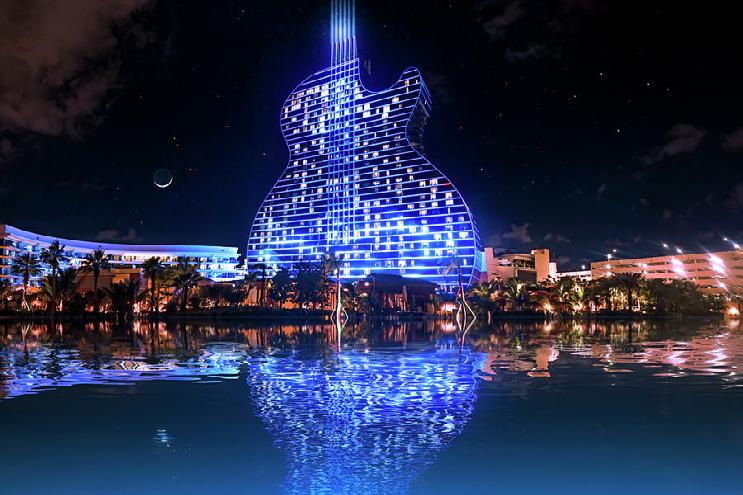

49 inparkmagazine.com
Taking a moment
Moment Factory: From music for the eyes to symphonies for the senses
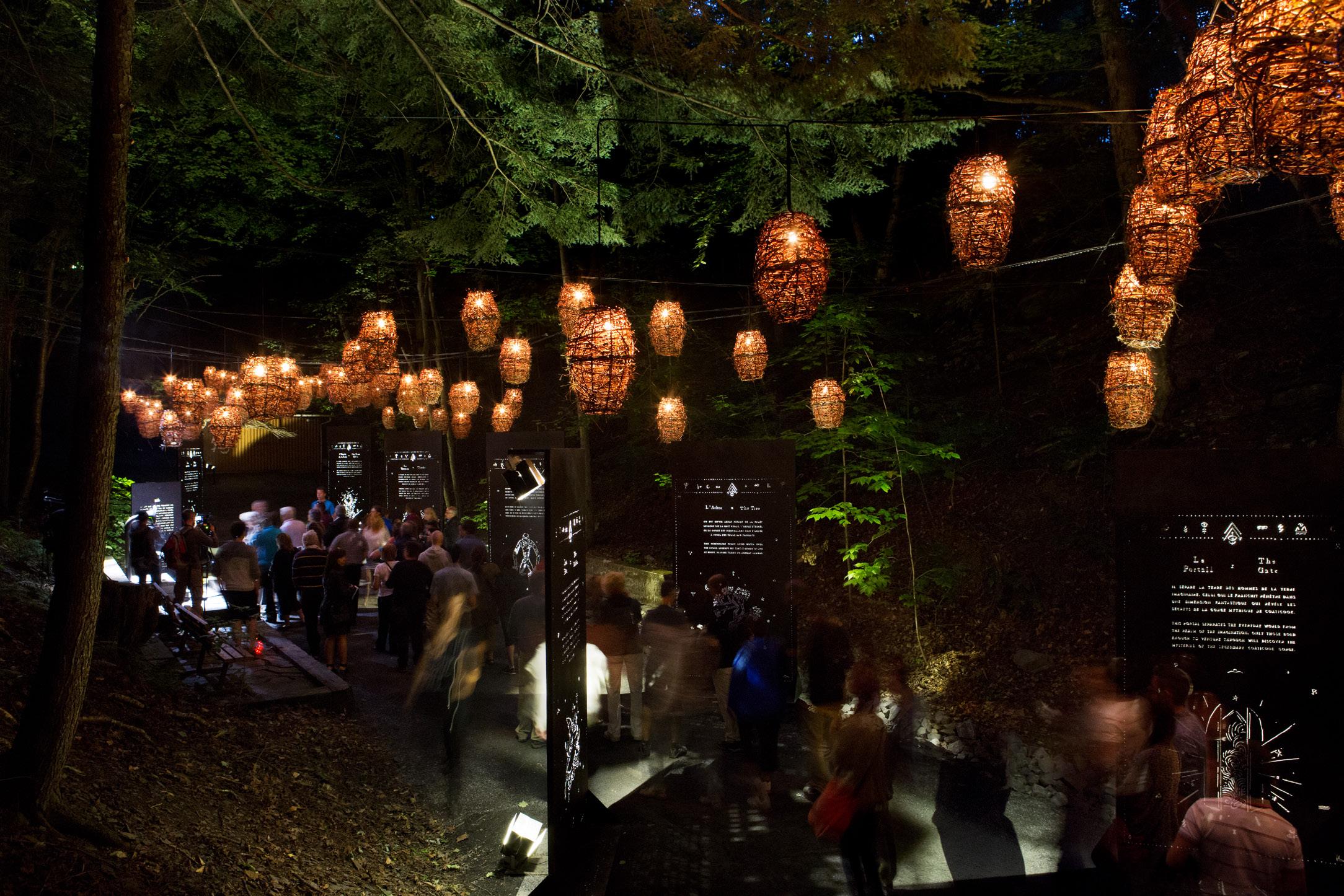 by Gene Jeffers
by Gene Jeffers
Born of early VJ gigs where Moment Factory’s founders offered “music for the eyes” and realized Cirque du Soleil projects, Montreal-headquartered Moment Factory has since taken on a wide range of complex, large-scale projects set in natural environments, iconic architectural, cultural and sacred sites, museums and public spaces. The team’s imagination and technology-stretching skills have graced everything from Nine Inch Nails’ Lights in the Sky Tour to Madonna’s Super Bowl Halftime show, from the Ode à la Vie multimedia show projected on the exterior façade of the Sagrada Familia to the interior mind-bending experience of AURA at the Notre-Dame Basilica.
Their motto proclaims, “We do it in public,” and that is entirely the point. “People are more and more isolated, and technology has, unfortunately, accelerated that isolation. Our inspiration is the campfire, a place where people once gathered to share stories and build connections,” says Catherine Turp, Executive
Director of Creation and Innovation at Moment Factory. She oversees the firm’s creative vision and innovative approaches, working closely with the founders and the creative team. “Our mission is to replicate the feeling of the campfire by creating magic, wonder and community. We spark human connections through unforgettable moments that bring people together.”
Moment Factory projects entice people to venture beyond the confines of their homes, to step away from their personal devices and home theaters into captivating experiences that can only happen in public spaces and in the real world. “How can we inspire people? How can we create moments of amazement? What does it take for people to want to gather physically in one place and join others?” Turp asks. “What does it take to stand out among the other attractions and distractions that surround us? We strive to find ways to offer more.”
50
inparkmagazine.com
Above: Foresta Lumina was the first of nearly 20 Lumina Night Walks. All photos courtesy Moment Factory
It takes a team to build a campfire Moment Factory’s success is due to its nature as a collaborative enterprise, both within the team itself and with the clients and partners of each project. The main objective is always to emotionally engage people within a given space and time. “We are approached with many opportunities and ideas. Our team then works with clients to understand their objectives and develop environments that will pull people in, engage them in an emotional story and in the environment,” Turp says. Whether building community awareness and pride, glamorizing travel hubs or honoring sacred spaces, collaboration remains key to every project the firm undertakes.
Lumina Night Walks
Nine years ago, a call from the operators of the Parc de la Gorge de Coaticook in Quebec provided a chance to offer more for the client and their guests. An invitation to light an iconic suspension bridge to attract after-dark visitors soon morphed into Foresta Lumina, a one-hour nighttime ticketed experience integrated within the gorge and its forest. “It was a simple request,” explains Turp. “After visiting the beautiful site, we saw an opportunity to go beyond the original mandate by bringing the local stories, legends and geography itself to life. Creating this enchanted night walk allows visitors to be fully immersed in the surrounding forest and landscape of Coaticook.” Guests explore Foresta Lumina’s charms at their own pace. The two-
kilometer-long trail invites them to escape for a few magical moments within a forest scenography enriched with videomapping, lighting effects and an original soundtrack.
Building on their success at Coaticook Gorge, the Moment Factory team, in collaboration with a wide range of partners, have created more than 18 additional site-specific Lumina Night Walk experiences in Asia, Europe and North America. Each Lumina Night Walk has its own personality, reshaping its outdoor venue with light, sound and local storytelling. “With each project, Lumina experience or otherwise, we explore possibilities, push familiar products to their limits and, when needed, hijack technologies from other industries. We test and retest, always looking for ways to immerse guests more deeply in the emotion of the story,” Turp says. “With all of our projects, the technology remains invisible, seamlessly integrated within the site, so as to never distract the audience.”
The AURA Project
Known for lavish staging and compelling exterior projection and sound works on heritage and sacred structures, Moment Factory’s AURA Projects generate multi-sensory experiences within structures, lavishing light, an original musical composition featuring choir and orchestra, projection mapping and story-telling within iconic architectural facilities.

51 inparkmagazine.com
The AURA Project started at the Notre-Dame Basilica in old Montreal.
The first AURA experience was created when the Fabrique de la Paroisse Notre-Dame of Montreal asked Moment Factory to create a sound, light and video show that would invite visitors to discover the Notre-Dame Basilica in old Montreal in a new way. “The challenge was to create a show that would captivate, touch, and inspire every visitor,” says Turp. The interior canvas offered whole new color, texture and scale challenges that required pushing precise pixel-by-pixel video-mapping to the extreme. “The experience had to highlight the Basilica’s artworks and architecture, all while respecting the religious heritage and regular activity of the church.”

Now beginning its sixth year as a ticketed experience, AURA at the Notre-Dame Basilica begins with a self-led tour of multimedia installations showcasing the facility’s cherished treasures. Visitors explore at their own pace until the main action begins. As one, the audience is immersed in lighting effects, projection-mapping, an original orchestral score and the basilica’s grandiose architecture, which are all made to flow together and transform the space before their very eyes. “As a guest, you don’t really understand all that goes into creating the beautiful dance that occurs between the various elements,” says Turp. “But you react; you feel the emotions. We are so lucky to work in these heritage sites, so privileged to bring them to life and share them with audiences.”
Thanks to the public’s enthusiastic response, the AURA experience series is expanding with the September 2023 launch of AURA Invalides in Paris, France. This monumental immersive undertaking fills the heart of the spectacular Dôme of the Hôtel national des Invalides. AURA Invalides builds and expands on the success Moment Factory has found in Montreal and in every one of its unique projects, as guests connect with the richness of the architecture and the stories of its heritage. “With every project, we learn more about our existing tools, and find new technologies to apply to our clients’ needs,” says Turp. “Every experience carries lessons that lead us to new solutions, that help us better understand how to connect with people and create community.”
Miroir Miroir/Mirror Mirror
The lessons learned were also applied to stage the Miroir Miroir/Mirror Mirror experience, a multi-part interactive art installation. Ticketed guests enter a chromatic and responsive world of light and sound that asks where do you go when you are lost in thought? Where do you go in your dreams? In Miroir Miroir/Mirror Mirror, thoughts generate poems, words become light, and gestures can spark a total transformation of one’s environment. Inspired by memory, imagination, dreams and consciousness, each of the distinct spaces invites guests to create their own special connection with the environment and with other guests.
52
inparkmagazine.com
The new AURA Invalides experience in Paris takes place in the heart of the spectacular Dôme of the Hôtel national des Invalides.
An additional Miroir Miroir/Mirror Mirror experience was created for the Illuminate Adelaide event, and Moment Factory is looking to grow this product into a new series worldwide.

Where next?
Moment Factory continues to evolve, ascending new heights of creativity for touring concerts and live events. In 2021, the studio prophetically worked with frequent collaborator Billie Eilish on Where Do We Go? The Livestream, a live concert experience. As it celebrates 22 years of pushing the limits of technology and entertainment, the team continues to mine the potential of its mission and motto: “We do it in public.” The future of public spaces is constantly being defined and redefined and so they explore new and innovative approaches for creating deeper, more meaningful moments. While Moment Factory’s early aspiration was to create music for the eyes, thanks to decades of creating and producing so many ever-more immersive storytelling experiences, this team of collaborators is now composing far richer symphonies for the senses.
Moment Factory is a multidisciplinary studio dedicated to creating innovative multimedia experiences that inspire human connections and transform the world around us. Our team combines expertise in video, lighting, architecture, sound and special effects to create remarkable experiences. Headquartered
in Montreal, the studio also has other addresses in Paris, Tokyo, New York City and Singapore. Since its inception in 2001, Moment Factory has created more than 500 unique projects worldwide, including the Lumina Night Walk and the AURA series. In collaboration with renowned artists, brands, museums, theme parks and cities, our productions span the globe and include such clients as Changi Airport, NotreDame Basilica of Montreal, Disney, Billie Eilish, Microsoft, the NBA, Sony, Boston Museum of Science, Universal Studios, The Toronto Zoo and the Reims Cathedral. Visit www. Momentfactory.com. •
Gene Jeffers, former (2001-2013) TEA Executive Director, is currently serving as a Board member for the Greater San Gabriel Pomona Valleys American Red Cross and serves on the Board of the Historical Novel Society. He continues to write in a variety of genres. Based in Pasadena, Gene and his wife Carol (also a writer) look forward to traveling and spending more time with their two daughters, son-in-law and three grandchildren.

53 inparkmagazine.com
An additional Miroir Miroir/Mirror Mirror experience was created for the Illuminate Adelaide event.
What’s in a MIRT (Mario in Real Time)?
SimGraphics ushers in well-behaved AI characters for LBE and themed attractions. AI-VActor™ technology powers new projects with Nintendo, Hasbro and the Chicago Field Museum
 by Judith Rubin
by Judith Rubin
SimGraphics proprietary AI-VActor™ technology will roll out in three new breakthrough interactive character experiences this year: The new and dynamic Super Mario attraction at the Nintendo Store in New York’s Rockefeller Center; a personification of Máximo, the notable Titanosaurus at the Chicago Field Museum; and Hasbro’s widely renowned Peppa Pig character for customized public spaces.
Building on modern-day artificial intelligence (AI) technologies, AI-VActor is an advanced system that can open doors for socializing with every spectator through personalized character interactions. These first three projects demonstrate its ability to move across a variety of applications and platforms, from entertainment to education, at levels never seen before, using autonomous AI characters.
This is something that has been long anticipated in the industry, now a reality. SimGraphics specialized software and engineering experts have been actively developing virtual characters since the 1980s. “Our company’s original VActor experiences were game changers when first launched decades ago and before artificial intelligence was refined for today’s personalized user experience in communal environments,” says Richard Parker, SimGraphics CEO.
Using special sensors attached to a live actor’s face, the original VActor transmitted and conveyed the actor’s words, movements, and facial expressions to an onscreen animated character, allowing the audience to interact in real-time. The new AI-VActor is able to accomplish the same real-time interaction without the need for the performer.
54
inparkmagazine.com
AI-VActor’s new Mario character attraction debuted in July 2023 on a 23-foot wide, curved screen at the Nintendo Store in NYC. Image courtesy SimGraphics
The confidence displayed in this new AI-VActor by its highprofile adopters is bolstered by the system’s “guardrails” programming that ensures the branded character remains on point, while responding in a realistic and responsive manner – making it an eligible match for trademarked brands and IPs (intellectual properties).
It’s-a me, Mario!

AI-VActor’s new Mario character attraction debuted in July on a 23-foot wide, curved screen at the Nintendo Store in NYC. Conversations had begun in 2018 between Nintendo and SimGraphics about using AI to create an autonomous experience. Nintendo’s vision was to create a branded experience that could appear in multiple locations, delivering personalized content and unique adventures.
“SimGraphics was being reinvented around AI and it was the right time to rejoin forces,” says Parker. Parker’s long history with the company began in 1987 when interning with thenVice President, Mike Fusco, SimGraphics current CTO. Parker was invited back to lead the company in 2019.




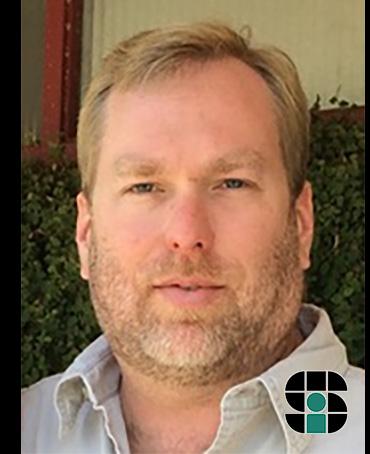

Though the pandemic interrupted the new Mario project, it also created an opportunity. “We finished the first AIVActor system and delivered to Nintendo in late 2019 – then everything shut down for two years,” Parker says. They took the time to refocus, bring in strategic advisors and make everything better. “We improved the entire system, and in addition we significantly improved conversational interface and content – enhancements that included a vision system so Mario could detect where guests are in the space, whether leaving or approaching,” says Parker. “The method of basic object detection, enabling Mario to react to physical things in a realtime environment, was essential.”

55 inparkmagazine.com
The ever popular Peppa Pig character. Hasbro’s new interactive Peppa experience “is only a starting point for our partnership with SimGraphics,” says Matt Proulx. Courtesy Hasbro
Eric Rodli SimGraphics
Ralph Miller Creative Executive Producer
Richard Parker SimGraphics
Rob Zschernitz The Field Museum
Matt Proulx Hasbro George Wade Bay Laurel Advisors
Mike Fusco SimGraphics
Nintendo was an early adopter of the original VActor system for its Super Mario experience (internally known as MIRT – Mario in Real Time) featuring the voice of actor Charles Martinet, who has voiced Mario in the Nintendo games since 1991. Ralph I. Miller, Creative Executive Producer contracting with Nintendo America since 1989, and instrumental in producing the original MIRT, recounted that Martinet showed up [late] for auditions to find an actor that would properly personify Mario for tradeshow exhibitions, using the original VActor. Miller said, “Charles just immediately took on the character that led to the creation of the first MIRT system, brought to life with his voice.”
SimGraphics created that first interactive Mario as a 3D-rendered head, prompting Martinet to spontaneously sing…“’I ain’t got no body,’” recalls Miller. In addition to appearances at tradeshows and gaming forums, Mario became a popular character for live appearances and at global events, and for many years those have been voiced live by Martinet (often remotely). Through AI-VActor, the lively persona he created for Nintendo’s beloved Mario character is being immortalized and protected, while able to be many places at once.
As Peppa Pig turns 20, a new beginning
For its first application of AI-VActor, Hasbro is showcasing Peppa Pig, just in time for the character’s big 20th anniversary
in 2024. Matt Proulx, Vice President, Location Based Entertainment with Hasbro, describes it as “a perfect fit, eliminating the traditional barriers between our characters and our youngest fans. It allows our fans to interact with Peppa in a way they never could before. Simply put, it breaks down that fourth wall that exists between viewers and the content.”
Proulx expressed that “Peppa being able to hold a conversation with the audience and recognize different questions is truly groundbreaking, and creates awe-inspiring, unforgettable experiences for the fans.”
Discussing Hasbro’s objectives, Proulx says, “Our highest priority is enforcing brand consistency in whatever venue, location, or type of guest experience. All too often, we must work hard to ensure how the brand comes to life across a variety of locations and experiences. AI-VActor eliminates that issue, as fans all over the world will experience the same quality of visual and audio elements as they interact with Peppa.”
Since he began with Hasbro in 2007, Proulx has shepherded many successful international LBE activations of Hasbro brands including Transformers, My Little Pony, Monopoly and more. “We’re always on the lookout for innovative technologies with the potential to unlock more efficient processes to save our licensees time and money,” says Proulx.

56
inparkmagazine.com
Real-life Máximo Titanosaurus skeleton at The Field Museum in Chicago. Courtesy The Field Museum
And it looks like there’s more to come soon. “This interactive Peppa experience is only a starting point for our partnership with SimGraphics,” says Proulx. “We intend to deliver even more interactive experiences for a host of Hasbro brands and characters, each with their own fantastical and passionate fan base. AI-VActor technology is meant to be used across as many attractions and experiences, due to the flexibility of its design and footprint. There’s so much potential left to unlock, and this is only the beginning!”
“Matt is a visionary,” says Eric Rodli, SimGraphics Chair and former CEO. “The most challenging part is creating the first character. Once tailored, the cost of implementation in different locations is relatively low. It supports a strong business model that works for the licensee but also protects the brand.” From 1988-1994, Rodli was President and CFO of Iwerks Entertainment (now SimEx-Iwerks), which partnered with SimGraphics to bring the original VActor to market.
The Chicago Field Museum: Máximo appeal Máximo is a fully constructed Titanosaurus skeleton, revealed in 2018 and centrally located in the museum’s Stanley Field

Hall. In this hub of the Museum, Máximo will spring to new life as a guest interplay animated attraction this year, utilizing AI-VActor technology.
Rob Zschernitz, CTO, The Field Museum explains, “Máximo will be now able to autonomously interact with visitors, to answer questions about himself and the Museum. We’re building a repertoire of questions and answers that will expand as needed – he already has a personality and dialogue, programmed by SimGraphics to meet the Museum’s specifications,” says Zschernitz.
The Field has a reputation for technical leadership, and since 2018 visitors have been able to engage with and learn from Máximo via a text-based chatbot interface. But after a couple of years, the chatbot was starting to feel dated. With a new strategic plan instigated by CEO Julian Siggers, Ph.D., who joined the Field in September 2020, the museum began exploring possibilities for a new Máximo interactive. The synergy started to crackle when Zschernitz saw AI-VActor demos after being introduced to the company via a Field Museum trustee.
57 inparkmagazine.com
AI Máximo. Courtesy SimGraphics
It’s all about bringing unique characters to life, whatever the venue or setting. As George Wade, President of Bay Laurel Advisors says, “Unique characters are a perfect fit for AIVActor technology and there are so many different aspects of consumer interaction available. This is truly a different experience in our industry and has tremendous potential for operators in all LBE forms.” Wade is a leading consultant on branded LBE and was recently named to the board of Licensing International. Working alongside Eric Rodli during their Iwerks Entertainment days, Wade was a driving force behind the development of original content, as well as IP blockbuster movies simulation experiences (think Robocop the Ride). Iwerks was also pioneering new exhibition models for mediabased attractions into nontraditional and educational markets.
The Field Museum’s example begins to unlock another potential for AI-VActor. Zschernitz portrays it by saying, “The new Máximo experience is likely only the beginning of how the Field will use SimGraphics technology. It’s rather a proof of concept, to see how audiences resonate with it.” If Máximo works out well, Zschernitz indicated that possible future applications could include using AI-VActor to create a virtual museum docent, and to utilize AI characters onto the museum’s other online platforms.
The added capacity to reach out in more directions and on more platforms is empowering for operators and educators alike. Zschernitz, who’s been with the Field Museum nearly 13 years and leads a team of 19 people, says, “A comprehensive visitor immersion strategy gives the ability to address a museum’s overall digital presence, both inside and outside the facility.” He adds, “There’s always this balance of being a physical space but wanting to reach as many as we can. Someone who may never experience Chicago can still be our audience with online programming and engagement. It’s transforming technology from something we do, to something we are.”
AI-VActor character development
Parker emphasizes, “In the world of autonomous experiences, with these new projects, we’re focused on bringing well-known brands to life while preserving brand integrity. AI on guardrails – also known as ‘directable AI,’ doesn’t learn on its own, doesn’t pick up bad words….is not a parrot. It has parameters that ensure it remains in character and can’t be led astray or go off brand – it’s always under control.”
Parker explained that drawing on rich material and with the right programming, an autonomous character can be well developed and engaging while maintaining guardrails and brand consistency in the presentation. “It’s a respectful process,” Parker says. “There are lots of nuances in every branded character that’s been built up over time. Generations grow up with them. Companies have greatly invested in them. It’s therefore essential to understand the personality of the character in what they would know or talk about, and things relevant to their world and location. There’s the conversational
aptitude, which includes the ability to handle things from left field, while staying in the universe of the character.”
“The stakes are huge,” says Rodli. “You must protect the IP – but there are other needs to be met as well. There might be four or five key players on a project – the IP licensor, operator, financial investor, creative, and core tech professionals. That’s four or five people to say ‘yes’ and to keep saying ‘yes’ as the project evolves. That’s the complexity of branded implementation.”
Once the basic character is established, it can be updated and refreshed with new material, and refined based on operations data. Guest privacy is protected. Rodli reinforces that, “We don’t track personally identifiable information, we only track that there is an individual in the space while they are interacting with the character, we log all the interactions. That’s information we can mine for expansion of the system to better understand consumer behaviors, and marketing insight – all valuable for IP holders when the consumer interacts directly with their brand.”
The benefits of experience
It helps that these three new projects involve some of the key players who helped introduce the original VActor, bringing passion, creativity, and decades of experience to help guide their clients to success.
“We have plenty of real-world experiences in actual environments, in dealing with the public, and creating attractions where people engage with virtual characters,” says Rodli. “This team can bring together creative and tech. We’re experienced pioneers in LBE and branded entertainment that allows us to leverage our networks and relationships. We speak the language of the project process and have a real understanding of operations and ROI.”
“As a pioneer in the virtual character arena over the past 30 years, SimGraphics has worked with most major players including Fox, Disney, the BBC, Dreamscape Immersive, T.V. Globo and Nintendo,” says Parker. “As trailblazers in virtual character development, using performance animation and digital puppetry, SimGraphics knows how to manage guests and crowds in all sorts of environments, whether large or small.”
Summing up, Parker says, “We love what we’re doing, and want to keep moving in this direction, combining high-quality brands and IP in all LBE spaces including museums, science centers, themed attractions, cinemas, retail, and educational markets. Part of our vision is to also take those characters into the digital in-home and in-school marketplace. That’s the big pitch!”
SimGraphics will have a presence at the IAAPA Expo in Orlando in November 2023. To set up a meeting or for more information, email info@simg.com. •
58
inparkmagazine.com

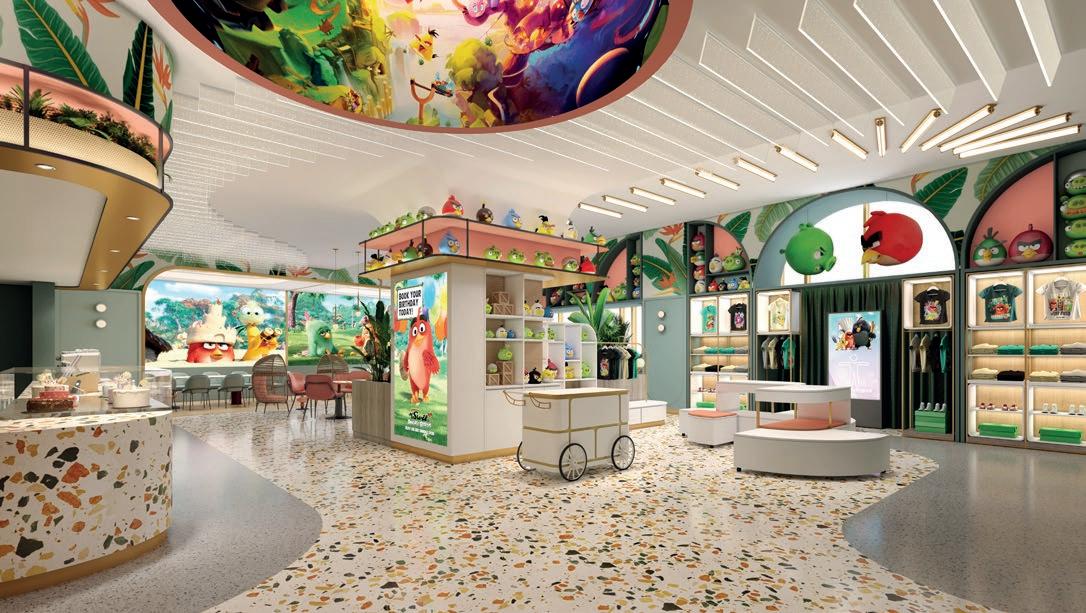









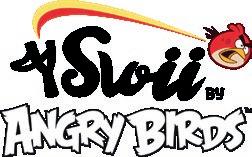

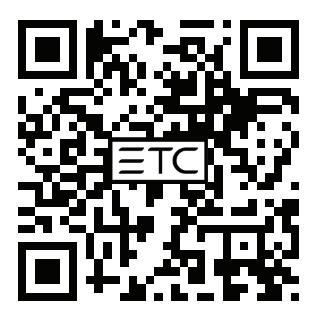
FIND YOUR LIGHTING SOLUTION AT etcconnect.com/themeparks ETC THEME PARK LIGHTING SOLUTIONS DELIVER EXTRA-SPECIAL SPECIAL EVENTS visual environment technologies | etcconnect.com Go ahead, make your special event even more special. ETC’s massive control capacity, integrated systems, and single-point administrative options help you deliver stunning transformations. No matter how many lights, how many colors, or how big you want to go, ETC makes controlling it all a walk in the park.
Photo Courtesy of Silver Dollar City, Branson, Mo




























































 by Judith Rubin
by Judith Rubin



































 by James Careless
by James Careless

























 by Tammie Richards
by Tammie Richards



 An RFID-enabled locker can be operated with the guest’s RFID ticketing tag, eliminating the need to carry multiple keys and tags.
An RFID-enabled locker can be operated with the guest’s RFID ticketing tag, eliminating the need to carry multiple keys and tags.




 by Gene Jeffers
by Gene Jeffers




 by Judith Rubin
by Judith Rubin























